
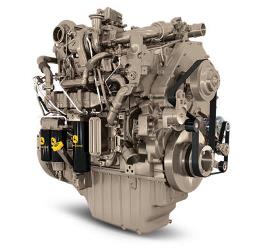 PowerTech PSS 13.5L (824 cu. in.) engine
PowerTech PSS 13.5L (824 cu. in.) engine
John Deere has engineered the PowerTech PSS 13.5L (824 cu. in.) engine to meet the high expectations for fuel economy and performance that operators expect.
Selective catalytic reduction (SCR) is an exhaust filter option that reduces NOx emissions. SCR technology increases in cylinder combustion temperatures to reduce particulate matter (PM) output but as a result of these higher combustion temperatures, it increases the NOx (smog) emission levels. To keep the NOx levels within acceptable standards, a urea-based additive, sometimes referred to as AdBlue® system or diesel exhaust fluid (DEF) is added into the exhaust stream to low NOx emission downstream of the engine. The urea mixes with engine exhaust gases in the catalytic converter. The resulting reaction of adding urea (NH3) (or purified fertilizer) into the exhaust stream and passing through a catalyst transforms the NOx which results in harmless nitrogen gas and water vapor.
Series turbochargers
Series turbocharging delivers higher power density, improved low-speed torque, and improved high-altitude operation. By splitting the compression of the charge air between two turbochargers, both can operate at peak efficiency and at slower rotating speeds. This lowers stress on turbocharger components and improves durability.
Series turbocharging works when fresh air is drawn into the low-pressure turbocharger (fixed geometry), where air pressure is boosted. This pressurized or boosted air is then drawn into the high-pressure turbocharger (VGT or WGT), where air intake pressure is further raised. The high-pressure air is then routed to an air-to-air aftercooler, where the air is cooled and routed to the engine’s intake manifold.
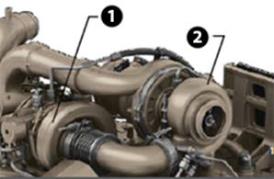 Series turbochargers
Series turbochargers
The PowerTech PSS 13.5L (824 cu. in.) utilizes two turbochargers – a variable geometry turbocharger (VGT) and a fixed geometry turbocharger, providing the torque rise and engine responsiveness to meet varying load conditions.
Fresh air is first drawn into the low-pressure fixed geometry turbocharger and compressed to a higher pressure. The compressed air is then drawn into the high-pressure VGT where the air is further compressed. The compressed air is then routed to the charge air cooler, and then to the intake manifold. By splitting the work between two turbochargers, both can operate at peak efficiency and at a slower rotating speed.
VGT
The VGT is electronically controlled and hydraulically actuates the turbo vanes as required to maintain peak engine performance.
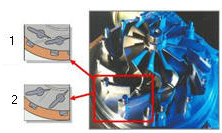 VGT vanes in exhaust flow
VGT vanes in exhaust flow
The turbocharger’s vanes are in the exhaust flow. The opening or closing of the vanes changes the outlet volume and airflow speed against the turbocharger impeller. When exhaust flow is low, the vanes are partially closed. This partial closure increases the pressure against the turbine blades to make the turbine spin faster and generate more boost pressure. The ability to keep the airflow flowing at optimum levels provides more consistent engine boost pressure and the ability to respond to load quickly across the entire engine rpm range. This system is without turbo lag as can be found on some engines. Boost pressure in the intake manifold is controlled at its optimum point for added fuel economy and performance regardless of rpm or load.
The overall benefits:
Air-to-air aftercooling
Air-to-air aftercooling lowers the intake manifold air temperature and provides more efficient cooling while reducing cylinder firing pressure and temperatures for greater engine reliability. Since low temperature air is denser, a higher volume of air flows into cylinders so the engine is capable of meeting the increasing horsepower demands.
 Electronic unit injector
Electronic unit injectorElectronic unit fuel injection system on the 13.5 L (824 cu. in.) engine provides the following benefits:
This engine control unit uses signal inputs from sensors and pre-programmed performance modeling to control critical engine functions such as fuel quantity, injection timing, air-to-fuel ratio, multiple fuel injections, amount of cooled exhaust gas recirculation (EGR), and a host of other control parameters to deliver peak fuel economy and engine performance.
Each injector is controlled individually by the ECU. The ECU turns the injector on and off during each firing cycle to control the fuel delivery into each cylinder. The ECU can sense engine speed and load changes at a rate of 100 times per second and respond instantly to them. Load and speed sensing allows each cylinder’s fuel delivery rate to be adjusted independently at the individual injector. With each injection cycle, the ECU can make the following adjustments on the go:
This management system is connected to the transmission allowing the engine and transmission to respond simultaneously.
Cold weather and high altitude compensation are also precisely controlled for quality starts regardless of weather and proper power levels at high elevations.
Noise reduction
The injection system also contributes to the engine running at a decreased noise level by a process called pilot injection. The precise fuel injection capabilities allow a small amount of fuel to be injected early in the combustion process. This helps lessen the combustion knock that is commonly heard on many diesel engines. While the combustion noise reduction is most obvious at lower engine speed, pilot injection continues to function at any engine speed.
The electronic control unit monitors various sensor inputs from the tractor and automatically changes the sheave ratio to change the fan speed. Hydraulic oil pressure is directed to the pistons that push the top inner sheave out (A), to close the gap and create a larger working diameter.
The bottom sheave (B) responds by compressing the coil spring, widening the gap between the two sheave halves, and creating a smaller working diameter to increase the fan speed.
To slow the fan, the valve opens, allowing oil to leave the piston, widening the upper sheave halves.
Automatic shutdown function
This feature monitors engine coolant temperature, engine oil pressure, and transmission oil pressures while the transmission is in the park position, and the operator is out of the seat. If any of the systems reach undesirable levels, the tractor will shut down, to help prevent further tractor damage.
AdBlue is a trademark of German Association of the Automobile Industry (VDA).
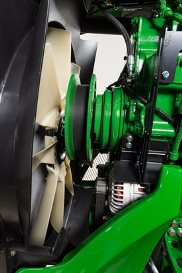 9R cooling package
9R cooling package
The Vari-Cool fan drive system precisely controls the speed of the fan in relation to the cooling requirements to maximize efficiency of the engine. The Vari-Cool system is efficient for two primary reasons:
Vari-Cool is integrated into the hood design
The Vari-Cool system is an integrated part of the hood design. Intake and outflow of air from the coolers is diverted to key openings in the hood structure. The design allows for airflow dispersion that lessens dust and crop kick-up by discharging the airflow away from the cab.
How Vari-Cool works
This electrohydraulic system uses variable speed drives. Actual fan speed is determined by the ratio differences of the top fan drive sheave to the bottom sheave.
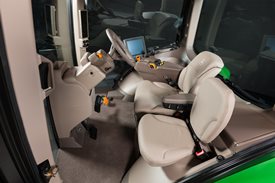 CommandView III cab
CommandView III cabThe standard CommandView III cab offers unsurpassed visibility, operator comfort, control placement, and ride and sound quality.
Features:
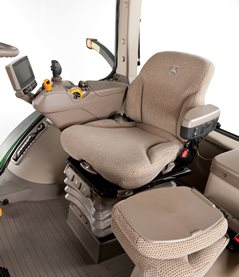 ComfortCommand seat
ComfortCommand seatComfortCommand seat improves ride quality and helps to reduce operator fatigue
Features include:
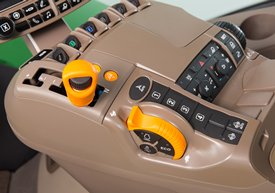 CommandARM controls
CommandARM controlsJohn Deere 9 Family Tractors feature the CommandARM with integrated Generation 4 CommandCenter display. The control layout of the CommandARM utilizes a clean and efficient design which groups controls by function and builds upon John Deere’s history of intuitive and ergonomic control placement and operation. The design of the CommandARM allows for a 40-degree right seat swivel and adjustable positioning matching the operator’s preference.
Controls located on the CommandARM include:
Hydraulic controls utilize fingertip paddle pots for raise/lower and extend/retract functions.
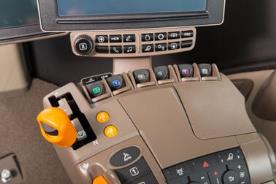 Fingertip paddle pots
Fingertip paddle potsThrottle
The throttle design incorporates buttons which control FieldCruise speed, and transmission eco settings.
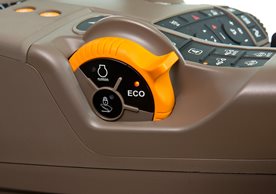 Throttle
ThrottleTractor function controls
Located just to the right of the throttle is the Auto-Trac activation button and four sequence controls for iTEC functions. Behind the iTEC sequence controls there are buttons which control the activation and deactivation of differential lock. Differential lock can also be activated by the foot switch on the cab floor.
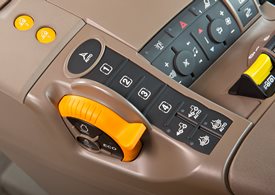 AutoTrac resume and iTEC strip
AutoTrac resume and iTEC stripControls for radio, lights, rotary beacon (if equipped), hazard flashers, and HVAC system are located to the center-right on the CommandARM, along with power take-off (PTO) for rear PTO.
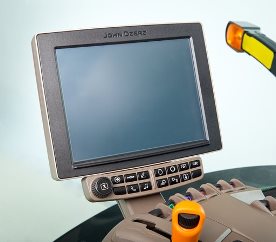 Generation 4 CommandCenter
Generation 4 CommandCenterThe Generation 4 CommandCenters features fast adjustment of tractor functions and controls and are integrated into the CommandARM to create a seamless control center.
The following functions can be adjusted and accessed using the CommandCenter display:
The Generation 4 CommandCenter systems have the capability of Remote Display Access (RDA). RDA allows improved communication between an offsite farm manager or dealer and the equipment operator. The user can view exactly what the operator sees on the GreenStar™ 3 2630 Display and Generation 4 CommandCenter from almost any internet-connected device. RDA is available on the 4600 and 4100 CommandCenter and allows for an increase in productivity with quicker problem resolution. By using RDA, the cost of operation will decrease due to reduced labor and travel costs, and maximum efficiency will increase profit.
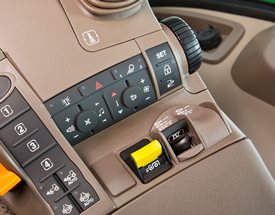 Radio, HVAC, hazard flashers, and PTO controls
Radio, HVAC, hazard flashers, and PTO controlsSeat swivel
The design of the CommandARM allows for up to 40 degrees of right-hand seat swivel.
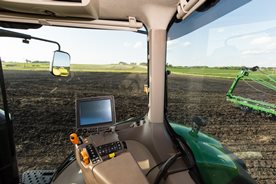 Seat swivel
Seat swivel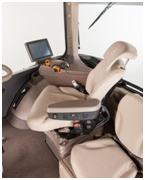 40-degree seat swivel shown
40-degree seat swivel shown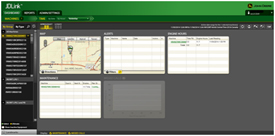 JDLink Dashboard
JDLink DashboardJDLink is the John Deere telematics system designed for operators and managers who desire to take their operations to the next level of productivity and efficiency without leaving the office. Whether it is receiving an e-mail or text message, users can manage the operation in real-time without being in the cab. Using the power of JDLink can optimize productivity, increase uptime, and boost profits with JDLink information all accessible from a laptop, desktop, or mobile device.
JDLink Ultimate provides enhanced machine performance and utilization information that can only be achieved through direct communication with on-board machine controllers. Utilizing John Deere-exclusive telematics technology, users can remotely link to Ultimate-compatible machines to achieve a new level of optimization.
NOTE: Mobile device compatibility and functionality varies.
Monitor assets, performance, and more with JDLink:
For more information on JDLink activations and subscriptions, visit www.StellarSupport.com.
NOTE: JDLink is not available in all geographic regions.
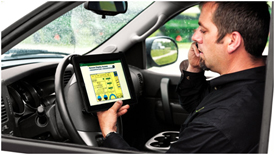 Service ADVISOR
Service ADVISORService ADVISOR diagnostics greatly assist in reducing service costs and downtime. It allows the John Deere service technician to readily extract vital information about tractor malfunctions through the Service ADVISOR data port. Diagnostic codes and controller area network (CAN) bus statistics stored by the tractor and visible in the CommandCenter™ display are used by service technicians to isolate, identify, and resolve problems.
Diagnostics and CAN bus statistics are not normally used by the operator. Access and use of trouble codes should only be done by a qualified, factory-trained John Deere service technician.
Service ADVISOR Remote takes the machine connectivity of JDLink and takes it one step further. With Service ADVISOR Remote, machines can be diagnosed remotely, saving the cost of a field service call. For example, diagnostic trouble codes can be reset and software updates can be uploaded remotely.
Apple, iPhone, and iPad are trademarks of Apple Inc. Android is a trademark of Google LLC.
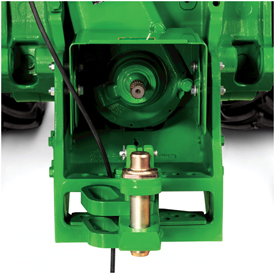 PTO and shield
PTO and shieldFully independent 1000-rpm PTO is available as a factory- or field-installed option.
9R – When the PTO is on and ground speed is 0.5km/h (0.31 mph) or less; PTO is limited to 335 hp.
9RT – When the PTO is on and ground speed is 0.5km/h (0.31 mph) or less; PTO is limited to 329 hp.
9RX – When the PTO is on and ground speed is 0.5km/h (0.31 mph) or less; PTO is limited to 335 hp.
See the specs page for model rated PTO horsepower.
The PTO shield has three positions — neutral, up, and down. Use the neutral position when the PTO is connected and ready for use. Use the up position for added clearance when connecting the PTO shaft to the tractor. The down position is used when the PTO is not connected and extra visibility to the drawbar is desired.
The 9 Family Tractors utilizes an electrohydraulic PTO-engagement switch to activate the optional 1000-rpm PTO.
If PTO option is not installed, a storage compartment is located on the rear of the tractor.
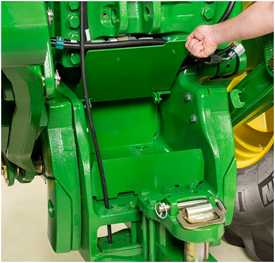 Rear storage compartment on 9R
Rear storage compartment on 9R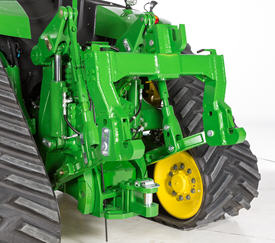 3-point hitch on 9RX
3-point hitch on 9RXThe 9 Family Tractors are designed to maximize performance for different applications. The 9R, 9RT, and 9RX Series Tractors offer two different hitch options:
9370R | 9420R/9420RX | 9470R/9470RT/9470RX | 9520R/9520RT/9520RX | 9570R/9570RT/9570RX | 9620R/9620RX | |
Category 4N/3 with quik-coupler, all axle diameters | Optional – 6804 kg (15,000 lb) | Not available | ||||
Category 4N/3 with quik-coupler, 120-mm (4.7-in.) axles required | Optional – 9072 kg (20,000 lb) | Not available | ||||
Category 4/4N with quik-coupler, all diameters axles | Optional: 6804 kg (15,000 lb) | |||||
Category 4/4N with quik-coupler, 120-mm (4.7-in.) axle required | Optional: 9072 kg (20,000 lb) | |||||
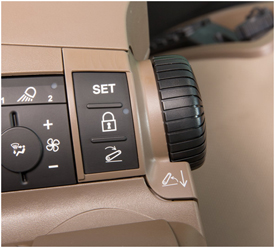 Hitch controls
Hitch controls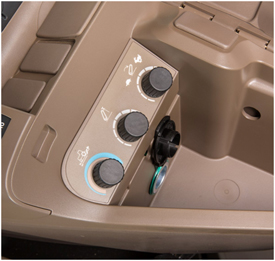 Field-installed 3–point hitch controls under armrest on CommandARM
Field-installed 3–point hitch controls under armrest on CommandARMTo help boost productivity, a field-installed kit with 3-point hitch controls can be purchased. If this option is selected, control buttons will be located on the 9 Family Tractor’s CommmandARM to access individual hitch settings. There are three buttons — set, lock, and load depth. There is also a rotary encoder that allows for finite movements of the hitch. The rotary encoder is detented, so it clicks for each movement. Additionally, hitch adjustment controls are located under the CommandARM for raise/lower rate.
Hitch load depth
The load depth feature is a useful tool designed to increase performance in tillage applications. Load depth adjustments allow the operator to make adjustments to hitch draft responsiveness.
Draft control helps maintain the operating depth in varying conditions, such as rolling terrain, and varying soil densities.
An additional feature with load depth control is the hitch slip option. Hitch slip uses wheel slip data to supplement the draft control system. If the wheels slip, the 3-point hitch lifts to allow the tractor wheels to maintain traction with the ground. Once the slip condition is no longer present, the hitch lowers to the required depth as determined by the hitch command and load depth settings.
Both of these hitch command options are easily programmable in the CommandCenter display by pressing the load depth shortcut key, followed by using the thumbwheel and confirm key to dial in the desired settings.
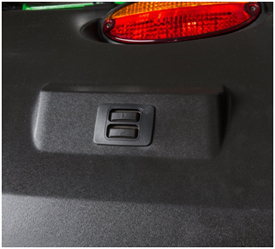 3-point hitch switch on fender of 9R
3-point hitch switch on fender of 9RFor added operator convenience, a 3-point hitch remote control switch is located on top of the left rear fender for 9R, 9RT, and 9RX Tractors. The external remote switches enable the operator to raise and lower the 3-point hitch from behind the tractor while hooking to implements.
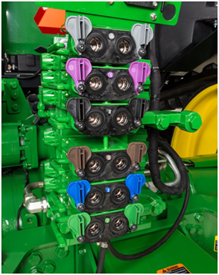 Selective control valve (SCV) stack
Selective control valve (SCV) stackOptional high-flow hydraulics are available on 9 Family Tractors by ordering code 3270. The high-flow hydraulic system provides an additional 215 L/min (57 gpm) of flow for a total of 435 L/min (115 gpm). This system is ideal for hydraulic fan motor demands. This system is recommended for agricultural implements with continuous flow requirements. When maximum hydraulic pump capacity is reached, multiple functions will continue to operate at the same proportional flow rate.
The 9 Family Ag High-Flow Tractors have two parallel hydraulic systems. The benefit of this system is that functions can be split between the two systems. Functions that require high flow and low pressure can be combined on one system (for example, air seeder fans, and planter motors). Functions that require high pressure and low-flow can be connected to the remaining system (for example, implement lift, fold, and constant down-pressure systems).
Following these guidelines allows the hydraulic system to run cooler as it prevents both hydraulic pumps from running at high pressure. In general, pumps forced to run at both high pressure and high flows generate much more heat than a pump running at a lower flow or lower pressure.
The system operates with two hydraulic pumps:
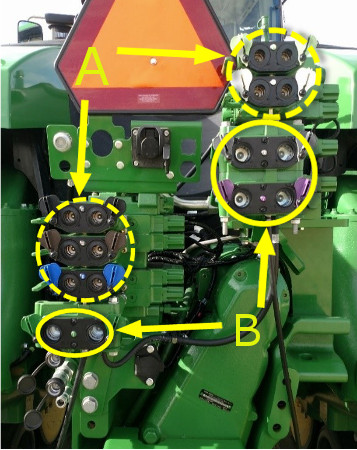 Five 1.3-cm (1/2-in.) couplers (A) and three 1.9-cm (3/4-in.) couplers (B)
Five 1.3-cm (1/2-in.) couplers (A) and three 1.9-cm (3/4-in.) couplers (B)For applications requiring continuous high hydraulic flow or multiple 1.9-cm (3/4-in.) hydraulic connections, this SCV stack is designed to maximize efficiency of the hydraulic system while providing additional flow using 1.9-cm (3/4-in.) couplers. Arrangement of the 1.9-cm (3/4-in.) couplers are split between the tractor’s dual hydraulic pumps to even the hydraulic load on each pump. Increasing coupler size from 1.3 cm (1/2 in.) to 1.9 cm (3/4 in.) allows an additional 26.5 L/min (7 gpm) or 17 percent more hydraulic flow through each coupler and reduces backpressure for hydraulic functions such as dual fan motors associated with the Air Power™ 2 system equipped on John Deere C850 Air Carts. With three 1.9-cm (3/4-in.) couplers available, operators can connect to other high-demand functions such as raise/lower. The 1.9-cm (3/4-in.) couplers also allow higher fan motor speeds for high-rate applications and allow more power to the ground due to less restriction on the hydraulic system.
NOTE: This SCV configuration is available on all double-reduction) axle 9420R to 9570R Tractors with high-flow hydraulics and all 9RX Tractors with high-flow hydraulics. This eight-section SCV stack does not include hydraulic Intelligent Power Management (IPM) software.
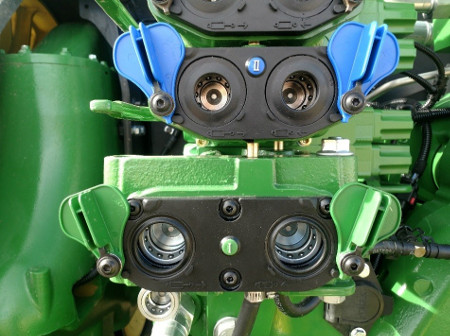 SCV couplers
SCV couplersConnections to 1.3-cm (1/2-in.) and 1.9-cm (3/4-in.) couplers are quick and simple for operators with a split SCV stack configuration at a comfortable connection height.
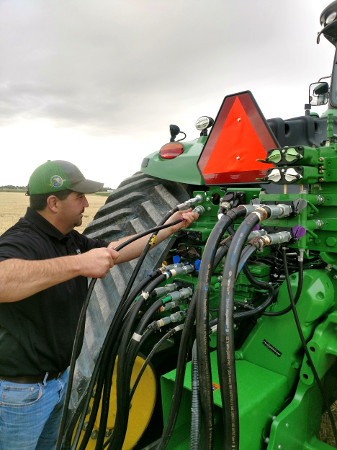 SCV connections in a stack configuration
SCV connections in a stack configuration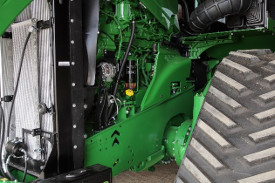 9R, 9RT, and 9RX service access
9R, 9RT, and 9RX service accessRegular service and maintenance are essential to the performance, productivity, and longevity of all farm machinery.
Maximum uptime is an important element of productivity.
All items in the daily service schedule can be performed without the use of tools:
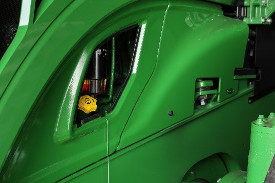 Engine oil service point
Engine oil service point
NOTE: Always refer to the operator’s manual for complete maintenance and service recommendations.
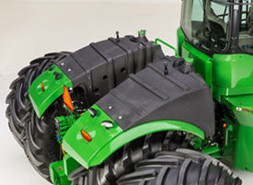 Fuel tank on the 9R
Fuel tank on the 9R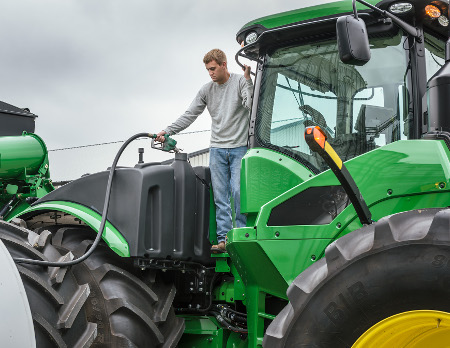 Refueling
RefuelingThe 9R Series Tractors fuel tank is located over the rear axle. The fuel tank features a dual fill design. This design allows the machine to be filled from either side of the fuel tank. A fuel nozzle holder is located when the operator positions themselves on the gudgeon platform to fill the fuel tank.
The diesel exhaust fluid (DEF) tank is located on the left-hand side of the tractor indicated by a blue cap. It is fillable from ground level and has a protective shield to keep debris out of the fill neck.
Model | Diesel | DEF |
9370R | 1211 L (320 gal.) | 120 L (31.7 gal.) |
9420R | 1514 L (400 gal.)* | 120 L (31.7 gal.) |
9470R | 1514 L (400 gal.)* | 120 L (31.7 gal.) |
9520R | 1514 L (400 gal.) | 120 L (31.7 gal.) |
9570R | 1514 L (400 gal.) | 120 L (31.7 gal.) |
9620R | 1514 L (400 gal.) | 120 L (31.7 gal.) |
*When equipped with double-reduction axle. 1211-L (320-gal.) when equipped with single-reduction axle.
9R, 9RT, and 9RX Series Tractors feature an easy-to-use DEF fill system. The 9R and 9RX feature a ground-level fill location, and DEF fill on 9RT is conveniently located on the step platform.
| Machine | DEF tank capacity |
| 9R | 120 L (31.7 gal.) |
| 9RT | 93.9 L (24.8 gal.) |
| 9RX | 120 L (31.7 gal.) |
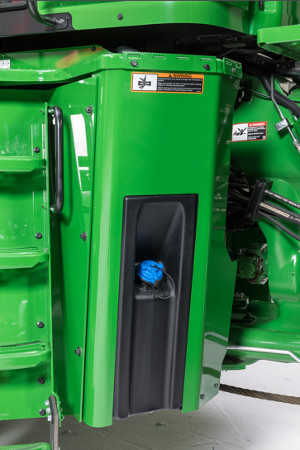 DEF tank on 9R/9RX
DEF tank on 9R/9RX9R, 9RT, and 9RX Series Tractors feature an in-line DEF filter to help protect the DEF pump from any contamination in the DEF tank. This in-line DEF filter is easily serviced with a drain plug to drain any remaining DEF from the filter housing and a replaceable cartridge-style filter.
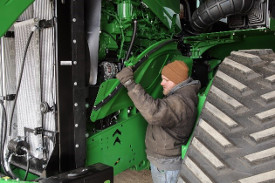 Engine access on 9RX
Engine access on 9RXThe tilt hood and side panel design provides additional engine compartment protection. The 9R, 9RT, and 9RX hoods feature the same design for access to engine components.
Pull out the hood release (located on the front, left side) and tilt hood back to open. Engine side panels are quickly and easily removed for access to periodic maintenance items.
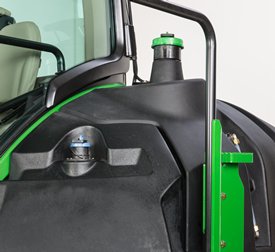 Fuel tank on the left side of 9RT
Fuel tank on the left side of 9RTThe 9RT fuel tank is located behind the cab; the fuel fill is located conveniently on the left-hand main platform.
The 9RT Series Tractors all feature a DEF tank capacity of 93.9 L (24.8 gal.). The fill location is near the diesel fill location.
Model | Diesel | DEF |
9470RT | 1325 L (350 gal.) | 93.9 L (24.8 gal.) |
9520RT | 1325 L (350 gal.) | 93.9 L (24.8 gal.) |
9570RT | 1325 L (350 gal.) | 93.9 L (24.8 gal.) |
Model | Diesel | DEF |
9470RX | 1514 L (400 gal.) | 120 L (31.7 gal.) |
9520RX | 1514 L (400 gal.) | 120 L (31.7 gal.) |
9570RX | 1514 L (400 gal.) | 120 L (31.7 gal.) |
9620RX | 1514 L (400 gal.) | 120 L (31.7 gal.) |
NOTE:
For more information about the use of bio-diesel in John Deere engines, refer to www.JohnDeere.com/biodiesel.
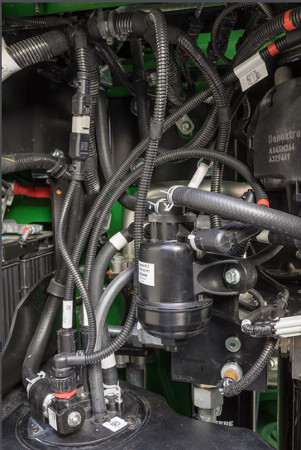 In-line DEF filter
In-line DEF filterSevere-duty water separator, if equipped
The severe-duty water separator can extend service intervals and helps to protect the tractor’s fuel system from damage associated with lower-quality fuel.
Simply open the drain valve on the bottom of the separator and drain accumulated water.
NOTE: Cummins® QSX 15 L (915.4-cu in.) engines cannot be equipped with a severe-duty water separator; however, the fuel filter has separating capabilities like the primary filter on John Deere Power System engines.
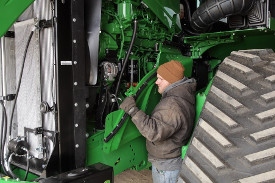 Removing side engine panel
Removing side engine panel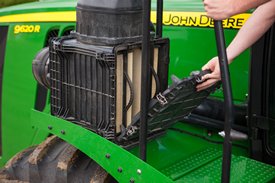 Primary engine air filter inspection
Primary engine air filter inspectionOn the 9R and 9RX, the primary engine air filter is accessible from the left-hand platform for replacement annually or as operating conditions require. The filter is aspirated and extends filter life in dusty conditions by aspirating more than 95 percent of incoming dust. Aspirator suction is created by utilizing the air flow from the cooling fan.
On the 9RT, the primary engine air filter is located at ground level on right side of tractor.
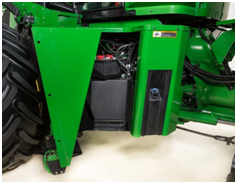 Battery location on 9R and 9RX
Battery location on 9R and 9RX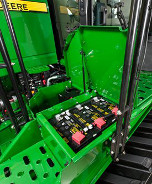 Battery location on 9RT
Battery location on 9RTThe 9R and 9RX battery location is behind the left-hand step assembly. There are three bolts that secure the swinging step assembly that need to be removed to completely access the batteries. The 9RT top step of the platform conceals the tractor’s three 12-V batteries with 2775 CCA (925-CCA each). Tractors with the Cummins X15 engine will have four 12-V batteries in the same location as tractors equipped with John Deere Power System engines.
Although the batteries are maintenance free, conditions such as long periods of operation at high ambient temperatures and excessive engine cranking may require adding water.
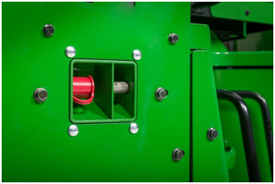 Battery boost terminal
Battery boost terminalOn the 9R and 9RX, a battery boost terminal is located on the left-hand side of the engine for convenient and proper boost assisted starting.
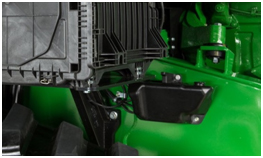 Windshield washer bottle on 9R and 9RX
Windshield washer bottle on 9R and 9RXThe windshield washer bottle is optional on 9R and 9RX Tractors and is located on the left side of the tractor near the DEF fill point. On 9RT Tractors, it is located on the right-side frame.
Maintenance-free U-joint bearings require no servicing to reduce maintenance time.
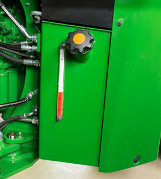 Sight gauge on 9R and 9RX
Sight gauge on 9R and 9RX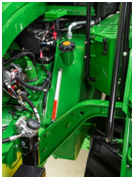 Sight gauge on 9RT
Sight gauge on 9RTA sight glass for the transmission, hydraulic, and axle oil level is located at the back right side of the gudgeon, indicating proper oil levels, and an oil fill neck is located on the back right side of the gudgeon for the 9R and 9RX Series Tractor. The oil fill is located on the top of the common reservoir on the left side of the 9RT Series Tractor and a fill tube is located between the steps and engine of the tractor.
NOTE: The tractor should be off and parked on level ground with the hitch in the lowered position when checking the oil level.
NOTE: Oil level above the top mark on the sight glass can result in power loss and heat generation during transport applications.
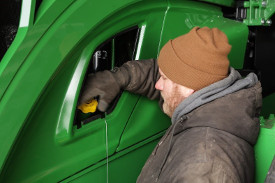 Engine oil check/fill location
Engine oil check/fill locationTractors with the 9.0L (549.2-cu in.) and 13.5L (823.2-cu in.) John Deere Power Systems engines feature a 500-hour change interval when using approved John Deere Plus-50™ II oil and a John Deere oil filter.
Tractors equipped with the Cummins QSX 15-L (915.4-cu in.) engine have a 400-hour engine oil and oil filter change interval.
See the tractor's operator's manual for oil change intervals and further details.
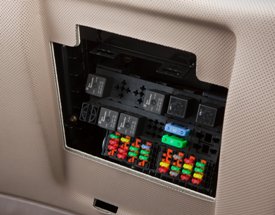 Fuse and relay panel
Fuse and relay panelThe electrical fuse and relay panel is located behind the operator’s seat and just below the cab's rear window. Simply lift up on the operator manual cover for access.
The diode module contains many of the diodes contained in the system:
Electrical system (smart load center)
The electrical system provides a full controller area network (CAN) bus based system on the tractor for improved tractor implement integration and flexibility. Incorporated with the system is a smart load center, which provides fewer fuses, fewer connectors, and simplified wiring for increased reliability.
The solid-state load center’s primary function is to control the majority of high-current loads, such as fender floodlights and the horn. This electronic circuitry will monitor loads and voltages to provide fast reaction time and the ability to alert the operator if a circuit overloads or if voltage is out of specification – for example, open circuit (undercurrent) or short circuit (overcurrent).
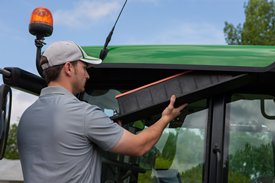 Cab fresh air filter inspection
Cab fresh air filter inspection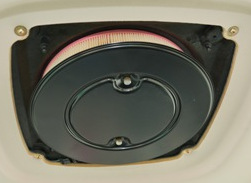 Cab recirculation filter
Cab recirculation filterThe cab fresh air filter is conveniently located beneath the left side of the cab for all 9 Family products:
Cab air recirculation filter
Cab air recirculation filter is located in the roof liner above the operator. 70 percent of the total air volume is recirculated with a blanket effect for enhanced operator comfort.
Cab air filters are not designed to filter out harmful chemicals. Follow the instructions in the implement operator’s manual and those given by the chemical manufacturer when using agricultural chemicals.
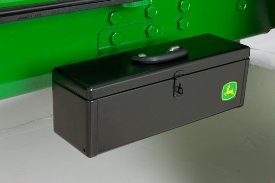 Toolbox for 9R, 9RT and 9RX
Toolbox for 9R, 9RT and 9RXA convenient toolbox is located on the left-hand side of the front frame for tool storage and comes standard on all 9R, 9RT, and 9RX Series Tractors.
9R and 9RX Series Tractors have an additional storage box conveniently located on top the left-hand platform.
The 9RT has an additional toolbox conveniently located next to the left side of the batteries for additional storage.
Cummins is a trademark of Cummins, Inc.
The e18 transmission delivers smooth shifting and intuitive controls in a reliable 18-speed PowerShift transmission. The e18 transmission with enhanced Efficiency Manager is standard equipment on all 9 Family Tractors.
The e18 has evolved from more than 50 years of John Deere PowerShift technology. With more automatic features, the e18 is easy to operate for all levels of operators and operations. It features three modes of operation, full AUTO, custom, and manual modes. Full AUTO and custom modes manage the engine and transmission to match the desired ground speed to the field conditions. These two modes are ideal for most conditions and take the guess work out of operation. Manual mode is perfect for operators looking to operate the e18 like a traditional PowerShift by bump shifting and managing the engine throttle to their liking.
As the next generation of PowerShift technology, the e18 delivers the strength to handle sudden, high-torque power loads while maintaining responsive, quick, and smooth shifts.
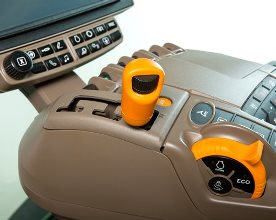 Shift lever and hand throttle
Shift lever and hand throttle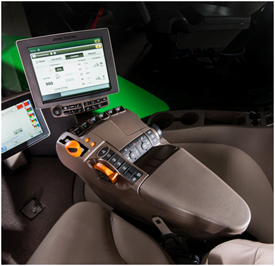 254-mm (10-in.) Generation 4 CommandCenter
254-mm (10-in.) Generation 4 CommandCenterThe CommandCenter is the central information system for tractors and allows the operator to program various settings tailored to a specific operation.
To access the tractor’s transmission settings, press the transmission shortcut button on the CommandCenter shortcut bar.
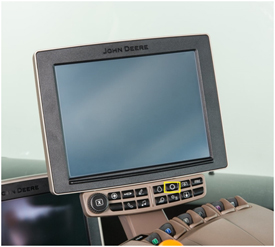 CommandCenter transmission shortcut button
CommandCenter transmission shortcut buttonOperating modes
The e18 application settings employ three modes to take full advantage of the engine-transmission communication: Full AUTO mode, custom mode, and manual mode.
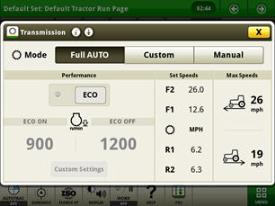 Full AUTO main page
Full AUTO main pageFull AUTO mode manages the tractor’s engine and transmission inputs to reach and maintain the desired ground speed set by the operator. This means the tractor will manage shifts and engine rpm to operate at the most efficient level possible. Operators have the ability to set the maximum forward and reverse speeds for their particular applications. In full AUTO mode the operator can adjust the desired ground speed in two ways, by conducting a traditional bump shift or by rotating the dial on the thumb wheel.
When shifting in full AUTO mode, the transmission shifts set speeds and does not always shift gears, meaning the transmission may not necessarily shift gears if it can reach the desired ground speed with a slightly higher or lower engine rpm. Efficiency Manager is automatically engaged while operating in full AUTO mode. As a result, shifting will not take the tractor out of Efficiency Manager in full AUTO mode.
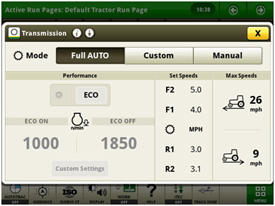 e18 custom transmission page
e18 custom transmission pageCustom mode operates similar to full AUTO mode but allows operators to adjust operating parameters to meet a specific operation. It also has the ability to activate eco mode for a higher level of operation.
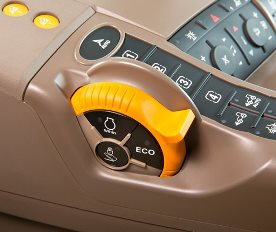 Eco button
Eco button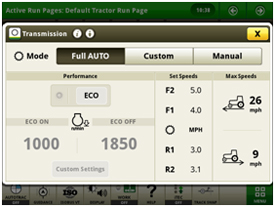 Display screen
Display screenEco allows two minimum engine speeds to be set. Operators can turn eco on and off by either pushing the eco button on the side of the throttle or by selecting eco in the transmission settings page of the CommandCenter controls. For example, operators may choose to turn eco on during transport to utilize a lower minimum engine speed and then turn eco off while operating in the field where a higher minimum engine speed is desired.
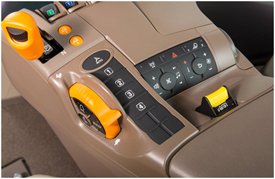 Set speed buttons and set speed adjuster
Set speed buttons and set speed adjusterEfficiency Manager is automatically enabled in auto and custom modes. Efficiency Manager can be turned on in manual mode by selecting the set speed one or set speed two button on the CommandARM™ console. The set speed adjuster on the top of the single-lever gear selector allows the operator to dial in the desired ground speed to establish set speed one or two. Once engaged, Efficiency Manager will manage the engine rpm and gear selection to maintain the desired working speed. To reach the desired set speed, the throttle must be set to full engine rpm.
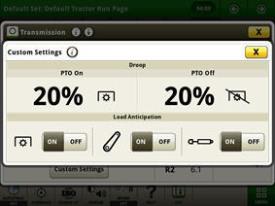 Custom settings page
Custom settings pageIn the advanced settings page, operators can customize the auto shift engine speed droop as a percentage of the full engine speed. In addition, the load anticipation feature can be enabled for the hitch engagement, hydraulic engagement, or both.
Manual mode
Manual mode operates very similarly to a traditional PowerShift transmission with Efficiency Manager.
In manual mode the operator manages the engine and transmission inputs by controlling the shift lever and hand throttle.
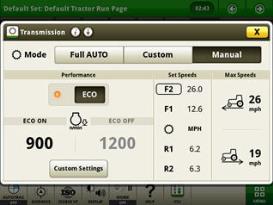 Manual mode page
Manual mode page e18 operation
e18 operationSetting start-up gears
The 9 Family Tractors default to 7F and 2R at start up. However, these default start-up gears can be adjusted from 1-13F and 1-3R through the CommandCenter. Refer to the operator’s manual for additional information.
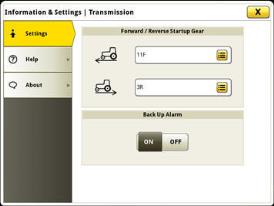 Start-up gears in advanced settings
Start-up gears in advanced settings9R Series Tractor - e18-speed chart for PowerShift transmission with Efficiency Manager
9R table
Group 47 tires | Group 48 tires | |||
Tire size | (480R46, 20.8R42, 520R42, 620R42, 710R38) | (480R50, 520R46, 620R46, 710R42, 800R38) | ||
Engine (rpm) | 2100 | 2100 | ||
18-speed gear | km/h | mph | km/h | mph |
Forward gears | ||||
F1 | 4.0 | 2.5 | 4.2 | 2.6 |
F2 | 4.8 | 3.0 | 5.0 | 3.1 |
F3 | 5.3 | 3.3 | 5.6 | 3.5 |
F4 | 5.9 | 3.7 | 6.2 | 3.9 |
F5 | 6.5 | 4.0 | 6.8 | 4.3 |
F6 | 7.3 | 4.5 | 7.6 | 4.8 |
F7 | 8.0 | 5.0 | 8.5 | 5.3 |
F8 | 9.0 | 5.6 | 9.5 | 5.9 |
F9 | 9.9 | 6.1 | 10.4 | 6.5 |
F10 | 11.0 | 6.9 | 11.6 | 7.2 |
F11 | 12.2 | 7.6 | 12.9 | 8.0 |
F12 | 13.5 | 8.4 | 14.2 | 8.8 |
F13 | 15.0 | 9.3 | 15.8 | 9.8 |
F14 | 16.6 | 10.3 | 17.5 | 10.9 |
F15 | 20.5 | 12.8 | 21.6 | 13.4 |
F16 | 25.3 | 15.7 | 26.6 | 16.5 |
F17 | 31.2 | 19.4 | 32.9 | 20.4 |
F18 | 38.5 | 23.9 | 40.5 | 25.2 |
Reverse gears | ||||
R1 | 3.9 | 2.4 | 4.1 | 2.5 |
R2 | 5.3 | 3.3 | 5.6 | 3.5 |
R3 | 5.9 | 3.7 | 6.2 | 3.9 |
R4 | 8.0 | 5.0 | 8.5 | 5.3 |
R5 | 9.0 | 5.6 | 9.5 | 5.9 |
R6 | 12.2 | 7.6 | 12.9 | 8.0 |
Group 47 tire based on 710/70R38
Group 48 tire based on 800/80R38
9RT and 9RX Series Tractor - e18-speed chart for PowerShift transmission with Efficiency Manager
9RT and 9RX table
| 9RT | 9RX | ||
Engine (rpm) | 2100 | 2100 | ||
18-speed gear | km/h | mph | km/h | mph |
Forward gears |
|
|
|
|
F1 | 4.0 | 2.5 | 4.0 | 2.5 |
F2 | 5.0 | 3.1 | 4.9 | 3.0 |
F3 | 5.5 | 3.4 | 5.5 | 3.4 |
F4 | 6.1 | 3.8 | 6.1 | 3.8 |
F5 | 6.8 | 4.2 | 6.7 | 4.2 |
F6 | 7.6 | 4.7 | 7.5 | 4.7 |
F7 | 8.4 | 5.2 | 8.3 | 5.2 |
F8 | 9.3 | 5.8 | 9.2 | 5.7 |
F9 | 10.3 | 6.4 | 10.2 | 6.3 |
F10 | 11.4 | 7.1 | 11.4 | 7.1 |
F11 | 12.6 | 7.8 | 12.6 | 7.8 |
F12 | 14.1 | 8.7 | 14.0 | 8.7 |
F13 | 15.6 | 9.7 | 15.5 | 9.6 |
F14 | 17.3 | 10.7 | 17.2 | 10.3 |
F15 | 21.4 | 13.3 | 21.3 | 13.2 |
F16 | 26.3 | 16.3 | 26.2 | 16.3 |
F17 | 32.3 | 20.1 | 32.2 | 20.0 |
F18 | 39.8 | 24.7 | 39.6 | 24.6 |
Reverse gears |
|
|
|
|
R1 | 4.0 | 2.5 | 4.0 | 2.5 |
R2 | 5.5 | 3.4 | 5.5 | 3.4 |
R3 | 6.1 | 3.3 | 6.1 | 3.8 |
R4 | 7.3 | 3.8 | 8.3 | 5.2 |
R5 | 9.3 | 5.8 | 9.2 | 5.7 |
R6 | 12.6 | 7.8 | 12.6 | 10.3 |
9RX Series Tractors equipped with 45.7-cm (18-in.) and 61-cm (24-in.) tracks feature a maximum speed of 42 km/h (26 mph).
9RX Series Tractors equipped with 45.7-cm (18-in.) or 61-cm (24-in.) tracks are advised to reduce ground speed based on axle load. 9RX Series Tractors equipped with 45.7-cm (18-in.) tracks will have a top speed set at the factory of 31 km/h (19 mph). Maximum speed may be adjusted up to 42 km/h (26 mph) upon review of the transport speed recommendations in the Operator’s Manual.
The speed reduction allows the undercarriage components and tracks to dissipate heat buildup caused by the higher axle loads, reducing undercarriage component and track damage. Increasing mid-roller surface area will increase the undercarriage ability to dissipate heat.
Narrow undercarriage with 45.7-cm (18-in.) tracks feature a narrower mid-roller matched to track width. This results in a smaller mid-roller surface area than 61-cm (24-in.) tracks, which are also matched to track width.
Producers who desire a 9RX machine for row-crop work and who also transport long distances with high axle loads should understand the limitations of the 45.7-cm (18-in.) and 61-cm (24-in.) tracks. 61-cm (24-in.) tracks with a greater mid-roller surface area will provide greater undercarriage and machine performance in transport while maintaining the ability to perform row-crop work. Comparing the transport speed recommendations for 45.7-cm (18-in.) and 61-cm (24-in.) tracks, the speed reduction is higher for 45.7-cm (18-in.) tracks for the same axle load.
9RX Series Tractors with a wide undercarriage and 76.2-cm (30-in.) or 91.4-cm (36-in.) tracks do not feature a speed reduction with increased axle load.
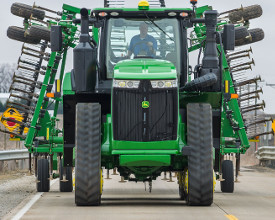 9RX in transport
9RX in transport9RX Series Tractor owners and operators need to be aware of axle loads and the recommended speed. The operator’s manual for both the machine and implement will have information on advised transport speeds. 9RX Series Tractors equipped with narrow undercarriage will also feature an in-cab window decal and reference card stored in the armrest for quick guidance on recommended transport speed based on axle load. Many implements may have a lower recommended transport speed than the tractor,; it is always advised to follow the lowest recommended transport speed.
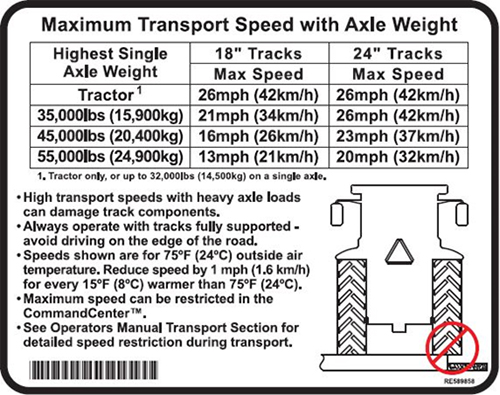 Maximum transport speed with axle weight
Maximum transport speed with axle weight| 1 mph increment | |||||||
| Single axle weight | 18 inch track max. | Single axle weight | 24 inch track max. | ||||
| (kg) | (lbs) | km/h | mph | (kg) | (lbs) | km/h | mph |
| 14,500 | 32,000 | 42 | 26 | 16,800 | 37,000 | 42 | 26 |
| 15,000 | 33,000 | 37 | 23 | 18,100 | 40,000 | 40 | 25 |
| 15,400 | 34,000 | 35 | 22 | 19,500 | 43,000 | 39 | 24 |
| 15,900 | 35,000 | 34 | 21 | 20,900 | 46,000 | 37 | 23 |
| 16,300 | 36,000 | 32 | 20 | 22,200 | 49,000 | 35 | 22 |
| 17,200 | 38,000 | 31 | 19 | 23,600 | 52,000 | 34 | 21 |
| 18,100 | 40,000 | 29 | 18 | 24,900 | 55,000 | 32 | 20 |
| 19,500 | 43,000 | 27 | 17 | 27,200 | 60,000 | 31 | 19 |
| 20,900 | 46,000 | 26 | 16 | ||||
| 22,200 | 49,000 | 24 | 15 | ||||
| 23,600 | 52,000 | 23 | 14 | ||||
| 25,400 | 56,000 | 21 | 13 | ||||
| 27,200 | 60,000 | 19 | 12 | ||||
| Application | Implement | Payload | Total tractor | Rear axle load (lbs) | Front axle load (lbs) | 18 inch (mph) | 24 inch (mph) |
| Other | 60' 2410C applicator | 400 | 61,400 | 30,000 | 32,000 | 26 | 26 |
| Primary Tillage | 9 shank 2720 (without rolling baskets) | 500 | 61,500 | 30,000 | 32,000 | 26 | 26 |
| Primary Tillage | 11 shank 2730 (gangs, without rolling baskets) | 484 | 61,484 | 30,000 | 32,000 | 26 | 26 |
| Secondary Tillage | 45' 2210LL cultivator | 1100 | 62,100 | 31,000 | 31,000 | 26 | 26 |
| Secondary Tillage | 40' 2623 VT | 1800 | 62,800 | 32,000 | 31,000 | 26 | 26 |
| Other | 60' 2510L 2400 gal (empty) | 3608 | 64,608 | 34,000 | 30,000 | 22 | 26 |
| Other | 1100 bu grain cart empty (Kinze 1100) | 3950 | 64,950 | 35,000 | 30,000 | 21 | 26 |
| Secondary Tillage | 45' 2310 mulch finisher | 4200 | 65,200 | 35,000 | 30,000 | 21 | 26 |
| Other | 1500 bu grain cart empty (Brent Avalanche 1596) | 3800 | 64,800 | 35,000 | 30,000 | 21 | 26 |
| Other | 1000 bu grain cart loaded (Brent 1082) | 4710 | 65,710 | 36,000 | 30,000 | 20 | 26 |
| Other | 1500 bu grain cart empty (Kinze 1500) | 5250 | 66,250 | 37,000 | 30,000 | 19 | 26 |
| Other | 1500 bu grain cart empty (Brent Avalanche 1596) | 5500 | 66,50 | 37,000 | 30,000 | 19 | 26 |
| Other | 1100 bu grain cart loaded (Kinze 1100) | 6280 | 67,280 | 38,000 | 29,000 | 19 | 25 |
| Other | 1100 bu grain cart loaded (Kinze 1500) | 7380 | 68,380 | 39,000 | 29,000 | 18 | 25 |
| Planters | DB60 47R15 CCS | 8340 | 69,340 | 41,000 | 29,000 | 17 | 24 |
| Planters | DB90 Planter | 12,300 | 73,300 | 46,000 | 27,000 | 16 | 23 |
| Planters | 1775NT 24R drawbar (need to verify) | 13,000 | 74,000 | 47,000 | 27,000 | 15 | 22 |
| Planters | DB120 Planter | 17,600 | 78,600 | 54,000 | 25,000 | 13 | 20 |
| Other | Hitch load | 15,000 | 76,000 | 54,000 | 22,000 | 13 | 20 |
NOTE: Example implements are for reference and direction only. Weigh the tractor and the amount of weight on the axle to determine the final recommended speed. Weights of implements will vary due to different configurations available between tractor and implement. Never exceed the maximum speed recommendation of any implement.
For producers who wish to limit vehicle top speed, transmission settings can be adjusted on the CommandARM™ display or user profiles can be established which locks out the ability to change vehicle top speed by the operator unless they enter the PIN.
| Window decal | |||||
| Single axle weight | 18 inch track max. | 24 inch track max. | |||
| (kg) | (lbs) | km/h | mph | km/h | mph |
| Tractor | 42 | 26 | 42 | 26 | |
| 15,900 | 35,000 | 34 | 21 | 42 | 26 |
| 20,400 | 45,000 | 26 | 16 | 37 | 23 |
| 24,900 | 55,000 | 21 | 13 | 32 | 20 |
Beginning with model year 2019 production, 9RX Series Tractors equipped with 76.2-cm (30-in.) and 91.4-cm (36-in.) tracks can be equipped with industry-exclusive, factory-installed track spacing set at 304.8-cm (120-in.).
9RX Series Tractors equipped with 304.8-cm (120-in.) track spacing provide increased stability, allow producers to operate on 304.8-cm (120-in.) centers for controlled traffic farming, and provide improved track-to-frame clearance for better access to the undercarriage for serviceability and material cleanout. John Deere is the first and only tractor manufacturer to offer a 304.8-cm (120-in.) track spacing option on four-track tractors with 76.2-cm (30-in.) and 91.4-cm (36-in.) tracks up to 462.3 kW (620 hp).
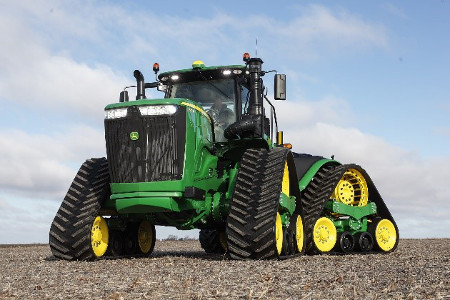 9RX with 91.4 cm (36 in.) tracks and 304.8-cm (120-in.) track spacing
9RX with 91.4 cm (36 in.) tracks and 304.8-cm (120-in.) track spacing9RX Series Tractors with 304.8-cm (120-in.) track spacing increase space between the undercarriage and chassis to provide more space for performing daily and routine maintenance tasks.
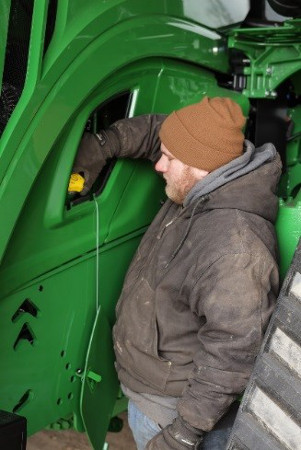 Performing daily maintenance tasks
Performing daily maintenance tasks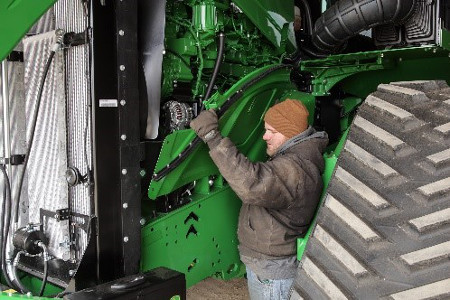 Performing routine maintenance tasks
Performing routine maintenance tasks| 9RX Series Tractors undercarriage configurations | ||||
 |  | |||
| Model | Narrow undercarriage | Wide undercarriage | ||
| Track spacing: 203.2 cm (80 in.), 223.5 cm (88 in.), or 304.8 cm (120 in.) | Track spacing: 223.5 cm (88 in.) or 304.8 cm (120 in.) | |||
| 45.7 cm (18 in.) tracks | 61 cm (24 in.) tracks | 76.2 cm (30 in.) tracks | 91.4 cm (36 in.) tracks | |
| 9420RX | • | • | --- | --- |
| 9470RX | • | • | • | • |
| 9520RX | • | • | • | • |
| 9570RX | --- | --- | • | • |
| 9620RX | --- | --- | • | • |
• Available
--- Not available
Compare the specifications of up to 4 models
| Key Specs | 9520rx-track-tractor Current Model |
|---|---|
| Engine description | John Deere PowerTech™ PSS 13.5L (B20 diesel compatible) |
| Engine displacement | 13.5 L 824 cu in. |
| Rated engine power | 382 kW 520 hp |
| Rated PTO power (hp SAE) | At 2,100 engine rpm: 249 kW 335 hp |
| Transmission type | Standard: John Deere e18™ 18-speed PowerShift with Efficiency Manager™: 40 km/h 25 mph |
| Hydraulic pump rated output | Standard: 220 L/min 58 gpm Optional: 435 L/min 115 gpm |
| Rear hitch category (SAE designation) | Category 4N/4: 6,804 kg 15,000 lb Category 4N/4: 9,072 kg 20,000 lb |
| Base machine weight | Narrow undercarriage: 23,587 kg 52,000 lb |
| Maximum PTO power | |
| Maximum engine power | |
| Engine specifications | |
| Description | John Deere PowerTech™ PSS 13.5L (B20 diesel compatible) |
| Engine type | Diesel, in-line, 6-cylinder, wet-sleeve cylinder liners with 4 valves-in-head |
| Engine family | JJDXL13.5310 |
| Rated speed | 2,100 rpm |
| Aspiration | Dual series turbocharger with fixed geometry first stage-variable geometry second stage - air-to-air aftercooling and cooled exhaust gas recirculation |
| Cylinders liners | |
| Emission level | Final Tier 4 |
| After treatment type | DOC/DPF/SCR |
| Displacement | 13.5 L 824 cu in. |
| Engine performance | |
| Rated power | 382 kW 520 hp |
| Rated PTO power (hp SAE) | At 2,100 engine rpm: 249 kW 335 hp |
| Power boost | 10 percent |
| Engine peak torque | At 1,600 rpm: 2,400 Nm 380 lb-ft |
| PTO torque rise | 38 percent |
| Intelligent Power Management (available in transport and/or mobile PTO applications) | |
| Maximum PTO power | |
| Maximum engine power | |
| Transmission | |
| Type | Standard: John Deere e18™ 18-speed PowerShift with Efficiency Manager™: 40 km/h 25 mph |
| Reverser | |
| Clutch; wet/dry | |
| Creeper | |
| Hydraulic system | |
| Type | Closed-center, pressure/flow compensated |
| Pump rated output | Standard: 220 L/min 58 gpm Optional: 435 L/min 115 gpm |
| Available flow at a single rear SCV | 0.5 in. couplers: 132 L/min 35 gpm |
| Available flow at front SCVs | |
| Number of rear selective control valves (SCVs) | Standard: ISO Couplers: 4-6 Optional: ISO Couplers: 7-8 (field installed) |
| Number of mid selective control valves (SCVs) | |
| Number of front selective control valves (SCVs) | |
| Joystick SCV control | |
| SCV control | Electronic |
| Rear hitch | |
| Hitch draft control load sense type | |
| Remote control valves available | |
| Hitch category (SAE designation) | Category 4N/4: 6,804 kg 15,000 lb Category 4N/4: 9,072 kg 20,000 lb |
| Maximum lift capacity behind lift points | Category 4N/4: 9,072 kg 20,000 lb |
| Sensing type | Electrohydraulic with draft sensing |
| Rear axle differential lock | |
| Lift capacity at standard frame | |
| Drawbar | |
| Drawbar category | Category 5 |
| Maximum vertical load | |
| Rear power take-off (PTO) | |
| Type | Independent 44 mm (1.75 in.) 20-spline, 1,000 rpm |
| Engine rpm (at rated PTO speeds) | |
| PTO actuation | |
| Ground speed PTO option availability | |
| Multispeed PTO option availability | |
| Front hitch | |
| Category | |
| Electric power | |
| Standard lift capacity | |
| Front power take-off (PTO) | |
| PTO speed | |
| Rear axle | |
| Type | |
| Final drive type | Bull gear and double idler with floating pinion |
| Differential controls | |
| Axle type | |
| Brakes, type and control | |
| Rear differential lock | Full-locking electrohydraulic |
| Load rating | |
| Front axle | |
| Type | |
| Front axle differential lock | Full-locking electrohydraulic |
| Load rating | |
| Tires | |
| Front | Tracks: 457 mm 18 in. Tracks: 609 mm 24 in. Tracks: 762 mm 30 in. Tracks: 914 mm 36 in. |
| Rear | Tracks: 457 mm 18 in. Tracks: 609 mm 24 in. Tracks: 762 mm 30 in. Tracks: 914 mm 36 in. |
| Wheel tread range | NArrow undercarriage: 2032 mm 80 in. 2235 mm 88 in. 3048 mm 120 in. Wide undercarriage: 2235 mm |
| Turning radius with brakes | |
| Turning radius without brakes | 6.4 m 21 ft |
| Steering | |
| Type | Standard: Hydraulic power-steering Optional: ActiveCommand™ Steering (ACS) |
| Electrical system | |
| Alternator size | Standard: 200 amp Optional: 240 amp |
| Battery options | 12 V |
| Total cold cranking amps | 925 CCA |
| Type of bulb in beacon (Halogen, Zenon, LED) | |
| Type of bulb in headlight (Halogen, Zenon, LED) | |
| Working lights | |
| dB(A) rating for backup alarm | |
| Operator station | |
| Rollover protective structure, OOS | |
| Seat | ComfortCommand™ |
| Cab suspension | Standard |
| Instructional seat | Standard |
| Display | Standard: 4100 Generation 4 CommandCenter™ with 7 in. display Optional: 4600 Generation 4 CommandCenter™ with 10 in. display |
| Radio | Standard: AM/FM stereo with weatherband, remote controls, auxiliary input jack, four speakers and external antenna |
| Inner cab volume | 3.597 m3 127 cu ft |
| dB(A) rating | |
| Cab glass area | 6.52 m2 70.18 sq ft |
| Front visibility | |
| Safety glass rating | |
| Dimensions | |
| Wheelbase | 4,128 mm 162.5 in. |
| Overall length | Excluding hitch: 7,637 mm 300.7 in. Including hitch and coupler: 8,217 mm 323.5 in. |
| Drawbar clearance | 403 mm 15.9 in. |
| Front axle center | |
| Approximate shipping weight, Open;Cab | Narrow undercarriage: 23,587 kg 52,000 lb Wide undercarriage: 24,494 kg 54,000 lb |
| Overall height | |
| Weight | |
| Base machine weight | Narrow undercarriage: 23,587 kg 52,000 lb Wide undercarriage: 24,494 kg 54,000 lb |
| Maximum ballast level | 28,122 kg 62,000 lb |
| Maximum permissible weight | |
| Capacities | |
| Crankcase oil volume | 48 L 12.7 U.S. gal. |
| Fuel tank | 1,514 L 400 U.S. gal. |
| Diesel exhaust fluid (DEF) tank | 83 L 22 U.S. gal. |
| Cooling system | 56.5 L 14.9 U.S. gal. |
| Transmission-hydraulic system | With 3-point hitch and PTO: 227 L 60 U.S. gal. Without 3-point hitch and PTO: 220 L 58 U.S. gal. |
| Serviceability | |
| Interval for engine oil change | 400 hours |
| Interval for hydraulic/transmission oil change | 1,500 hours |
| Interval for engine coolant change | 6,000 hours |
| Loaders | |
| Loader | |
| Lift capacity at full height | |
| Maximum lift height | |
| Precision AG | |
| Guidance | AutoTrac™ Ready |
| Telematic | Available with JDLink™ hardware, activations, and Ethernet Harnesses (availability dependent upon destination) |
| Remote diagnostics | Available with activated JDLink hardware and activations |
| Miscellaneous | |
| Country of manufacture | USA |
| Side slope rating | |
| Uphill/downhill slope rating | |
| Tracks | |
| Drive type | |
| Midrollers | |
| Track width | |
| Tread spacing |


The 9RX narrow track machines are designed for row-crop use and come with a variety of spacing configurations. Based on producer row-crop spacing needs, the 9RX narrow track can be ordered from the factory set to 203.2-cm, 223.5-cm, or 304.8-cm (80-in., 88-in., or 120-in.) spacing.
These attachment kits are available to change the machine spacing if row spacing needs to be changed to another size.


The 9RX narrow track machines are designed for row-crop use and come with a variety of spacing configurations. Based on producer row-crop spacing needs, the 9RX narrow track can be ordered from the factory set to 203.2-cm, 223.5-cm, or 304.8-cm (80-in., 88-in., or 120-in.) spacing.
These attachment kits are available to change the machine spacing if row spacing needs to be changed to another size.


The 9RX narrow track machines are designed for row-crop use and come with a variety of spacing configurations. Based on producer row-crop spacing needs, the 9RX narrow track can be ordered from the factory set to 203.2-cm, 223.5-cm, or 304.8-cm (80-in., 88-in., or 120-in.) spacing.
These attachment kits are available to change the machine spacing if row spacing needs to be changed to another size.
The rotary beacon light is installed to meet requirements in commercial or governmental applications. The rotating, high-intensity light rests securely within an amber-colored safety lens. Both the light and lens are replaceable if damaged.
The rotary beacon light features a fully adjustable, double-clamp design that provides a more rigid vertical support stem.
The rotary beacon light is installed to meet requirements in commercial or governmental applications. The rotating, high-intensity light rests securely within an amber-colored safety lens. Both the light and lens are replaceable if damaged.
The rotary beacon light features a fully adjustable, double-clamp design that provides a more rigid vertical support stem.
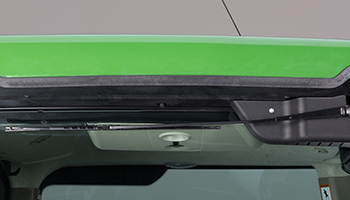 Right-hand window wiper
Right-hand window wiperOptional right-hand window wiper with washer fluid is available on standard and premium cabs. This option allows the operator to clean the window in dusty conditions from the comfort of the cab. The windshield wiper fluid tank is located on the operator platform near the front of the cab.
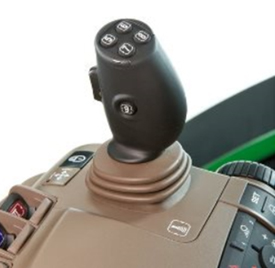
This optional cross-gate joystick replaces fingertip paddle pots for control of selective control valves (SCVs) and allows for programmable hydraulic functionality according to operator preference.
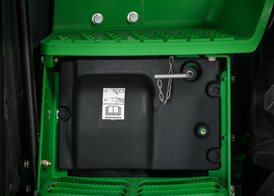 Battery disconnect installed
Battery disconnect installedAvailable as either a factory- or field-installed attachment, the battery disconnect switch is used to disconnect the batteries in preparation for 20-day to 90-day storage periods. The switch cuts the power to the entire tractor to aid in maintaining battery life.
An indicator light allows for safe and proper disconnect. The light will flash until it is safe to disconnect. This allows the diesel exhaust fluid (DEF) tank and lines to purge. (Final Tier 4 has an indicator light and Interim Tier 4 has no indicator light.)
Cummins is a trademark of Cummins Incorporated.
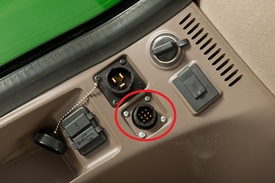 ISO 11783 location in R-Series Tractor cab
ISO 11783 location in R-Series Tractor cab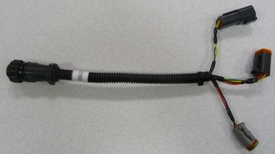 RE322780 ISO cab implement CAN bus adapter
RE322780 ISO cab implement CAN bus adapterThe ISO cab implement controller area network (CAN) bus adapter is available to connect any ISO compliant implement or device to an 8R, 8RT, 9R, 9RT, 9RX (including Scraper Special) Series Tractor. These connectors are commonly used for planter frame control boxes.
Refer to the operator's manual, sections 16 (CommandCenter™) and 25 (Operator Station), for additional information on ISO implements.
NOTE: If the harness is not in use, unplug it from the ISO 11783 location or plug the 4-pin connectors together on the harness. If neither of these are done, implement CAN communication errors will occur.
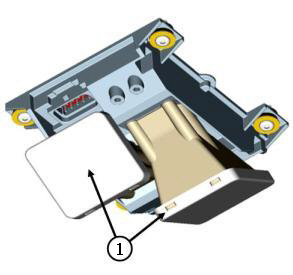 Dual-beam radar emission horns
Dual-beam radar emission horns 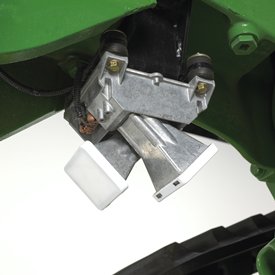 Dual-beam radar (tracks tractor shown)
Dual-beam radar (tracks tractor shown)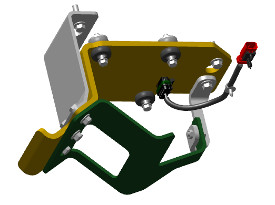 Shield for dual radar beam
Shield for dual radar beamIn today’s agricultural environment, accuracy and precision are more important than ever. For something as basic as ground speed, operators need key information for precise control of various implements and the tractor. To support these needs, tractors can be ordered with a dual-beam radar unit as a factory- or field-installed option.
There are several key features that have changed from previous designs.
First, there are two horns for exit of the radio beam. This dual-beam design assures a powerful and accurate signal that will cut through interference that at times makes single-beam units inaccurate. (See 1 in the image above for beam locations.) Dual-beam output makes radar less susceptible to hard surface or tall/wavy grass interference.
Accuracy is aided by a heavy-gauge mounting bracket and rubber isolators that reduce chances that vibration can affect the radio signal.
Dual-beam radar has a fast update rate. When the tractor comes to a stop, accelerates, or varies speed, the indicated ground speed on the tractor display will closely match the actual ground speed. This is important for implements that use radar speed to control operation such as planters, seeders, fertilizer applicators, and sprayers.
In addition, the dual-beam radar does not require calibration to assure accuracy. Its self-calibrating ability is sure to save setup time by elimination of a special procedure that was required in the past.
The radar true ground speed sensor activates the following CommandCenterTM display or performance monitor readouts:
Radar usage improves the accuracy of the following CommandCenter or performance monitor functions:
Dual-beam units are compatible with controller area network (CAN) bus and International Organization for Standardization (ISO) bus electrical systems.
 Dual-beam radar emission horns
Dual-beam radar emission horns  Dual-beam radar (tracks tractor shown)
Dual-beam radar (tracks tractor shown) Shield for dual radar beam
Shield for dual radar beamIn today’s agricultural environment, accuracy and precision are more important than ever. For something as basic as ground speed, operators need key information for precise control of various implements and the tractor. To support these needs, tractors can be ordered with a dual-beam radar unit as a factory- or field-installed option.
There are several key features that have changed from previous designs.
First, there are two horns for exit of the radio beam. This dual-beam design assures a powerful and accurate signal that will cut through interference that at times makes single-beam units inaccurate. (See 1 in the image above for beam locations.) Dual-beam output makes radar less susceptible to hard surface or tall/wavy grass interference.
Accuracy is aided by a heavy-gauge mounting bracket and rubber isolators that reduce chances that vibration can affect the radio signal.
Dual-beam radar has a fast update rate. When the tractor comes to a stop, accelerates, or varies speed, the indicated ground speed on the tractor display will closely match the actual ground speed. This is important for implements that use radar speed to control operation such as planters, seeders, fertilizer applicators, and sprayers.
In addition, the dual-beam radar does not require calibration to assure accuracy. Its self-calibrating ability is sure to save setup time by elimination of a special procedure that was required in the past.
The radar true ground speed sensor activates the following CommandCenterTM display or performance monitor readouts:
Radar usage improves the accuracy of the following CommandCenter or performance monitor functions:
Dual-beam units are compatible with controller area network (CAN) bus and International Organization for Standardization (ISO) bus electrical systems.
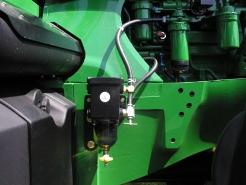 7030 Series Large-Frame Tractor shown
7030 Series Large-Frame Tractor shownThe severe-duty water separator factory-installed option or field-installed kit is available for locations where fuel quality can at times be in question. This kit will extend service intervals and help protect the tractor fuel system from damage if the fuel contains more water than the base filtering equipment can handle on a continual basis.
The 60 micron constructed of stainless-steel filter element must be backflushed whenever the bowl is half full of water. The filter can be backflushed up to five times before the filter must be removed and cleaned. Filter element must be replaced when light is no longer visible through the filter. The replacement interval will vary depending on fuel quality.
The following tractor combinations are either recommended or required to install front axle and rear support kits (see chart) based off of machine configurations.
Front frame and axle support kits
Front frame and axle support kits provide additional support to the front frame and axle joint when the tractor is used in applications that put high torque and high vertical loads on the front end of the machine. This includes front-mounted spray tanks.
9RX Series Tractors
A front frame support kit (BRE10401) is required on all 9RX Series Tractors with front-mounted spray tanks. This kit enables operators to utilize the 9RX Tractors for supplemental crop nutrition application or for utilizing a 3-point hitch mounted sprayer. The front frame supports are standard on all 9RX Scraper Tractors.
9000 and 9R Series Wheel Tractors
Tractor models | With HydraCushion™ suspension | With front ballast | With front-mounted spray tanks |
9370R-9470R | --- | BRE10198 required | BRE10198 required |
9520R-9620R | BRE10145 required | --- | --- |
Previous models |
|
|
|
9R Series | --- | RE341567 required | RE341567 required |
9030 Series | --- | RE267769 recommended | RE267769 required |
9000 Series/9020 Series | --- | RE213187 recommended | RE213187 required |
For 9460R-9560R Scraper Tractors, please order RE341567 when using front ballast or front-mounted spray tanks. No front support is needed on 9470R-9620R Scraper Tractors.
NOTE: All 9000 and 9R Series Tractors require additional front axle and frame support when used with front-mounted dozer blades. This support is in place of the front axle support and is supplied by the dozer blade manufacturer. Please contact the dozer blade manufacturer for additional information.
Rear axle support kits
The rear axle support provides additional support to the rear frame and axle joint when the tractor is used in applications that put high torque and high vertical loads on the back end of the machine.
9RX Series Tractors
The rear axle support (code 8042) is required when a hitch is ordered on any 9RX Series Tractors; it is optional without a hitch. Rear axle supports are standard on all 9RX Series Scraper Tractors.
9000 and 9R Series Wheel Tractors
Tractor models | High vertical load or heavy draft applications | With order code 8000 (heavy-duty frame) | With 6940-kg (15,000-lb) hitch option, code 4050 or 4051 | With 9072-kg (20,000-lb) hitch option, code 4052 or 4053 |
9370R-9470R | RE268085 recommended | RE268085 recommended | RE268085 recommended | RE268085 required |
9520R-9620R* | --- | --- | --- | --- |
Previous models |
|
|
|
|
9R Series model year 2012 to model year 2014 | RE268085 recommended | RE268085 recommended | RE268085 recommended | RE268085 required |
9030 Series | RE268085 recommended | RE268085 recommended | RE268085 recommended | --- |
*The rear axle support is not available on 9520R – 9620R Tractors because the double reduction axle design already provides this level of support.
Mounting of dozer blades:
The mounting of dozer blades is approved on 9R Series and 9RX Series Tractors with 30-in. and 36-in. tracks. The mounting of dozer blades is not approved on 9RT Series Tractors and 9RX Series Tractors with 18-in. and 24-in. tracks.
NOTE: 9R Series and 9RX Series Tractors with 30-in. and 36-in. tracks are approved for typical agricultural applications, such as packing silage, pushing snow, and non-commercial dirt moving blade work. 9RX Series Tractors with 18-in. and 24-in. tracks are not approved for front blade work.
For implements that require high hydraulic flow, 19-mm (3/4-in.) couplers are available in two configurations.
A single 19-mm (3/4-in.) selective control valve (SCV) coupler is available as a field-installed attachment for dual-pump, 435-L/min (115-gpm) hydraulic systems.
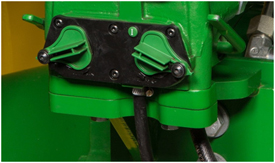 19-mm (3/4-in.) coupler
19-mm (3/4-in.) couplerHydraulic Intelligent Power Management (IPM) with three 19-mm (3/4-in.) and five 12.7-mm (1/2-in.) SCV couplers are available as a factory- or field-installed attachment on 9620R and 9620RX Tractors equipped with dual-pump, 435-L/min (115-gpm) hydraulic systems.
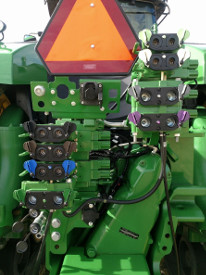 Color-coded SCVs
Color-coded SCVsAdditional 140-L/min (37-gpm) standard flow SCVs with 1.3-cm (1/2-in.) couplers can be field-installed for those who need to control additional hydraulic functions. Kits include ISO lever-assisted breakaway couplers and armrest control lever.
Reference the table below for kit options to add a fifth, sixth, or seventh and eighth SCV.
1.9-cm (¾-in.) SCV coupler kit
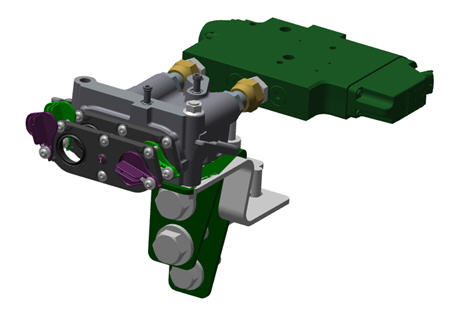 1.9-cm (¾-in.) SCV coupler kit (BRE10107 shown)
1.9-cm (¾-in.) SCV coupler kit (BRE10107 shown)For greater versatility, producers can replace one 140-L/min (37-gpm) standard flow SCV and 1.3-cm (½-in.) coupler with this 170-L/min (44.9-gpm) high-flow SCV and 1.9-cm (¾-in.) coupler.
1.9-cm (¾-in.) coupler adapter conversion
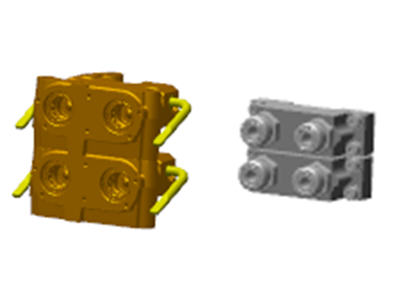 BRE10486 1.9-cm (3/4-in.) coupler and adapter (two kits shown stacked)
BRE10486 1.9-cm (3/4-in.) coupler and adapter (two kits shown stacked)The conversion design is exclusive to John Deere and converts the couplers on a standard flow SCV from 1.3-cm (½-in.) couplers to 1.9-cm (¾-in.) couplers (with a maximum of 140 L/min [37 gpm]). This kit is ideal for operators with:
This conversion is an economical solution to improve the transfer of hydraulic horsepower from the tractor to the implement.
 SCV connections in a stack configuration
SCV connections in a stack configurationThe seeding hydraulic IPM kit adds three 1.9-cm (¾-in.) hydraulic couplers with 170-L/min (44.9-gpm) high-flow SCVs onto the rear of the machine to supplement the additional hydraulic power and flow consumed by systems running dual fan motors such as the Air Power™ 2 system equipped on John Deere C850 Air Carts.
Also provided in the kit is a software enhancement for controlled power increase of up to 18.6 engine kW (25 engine hp) at 2100 rpm and “power limited” in gears 5 through 18 and 37.3 engine kW (50 engine hp) in gears 1 through 4. Power increase is only provided when required.
Field installed kit includes:
For the complete description of the capabilities of this kit, please see the seeding hydraulic IPM feature which will provide the factory-installed option code for this same system.
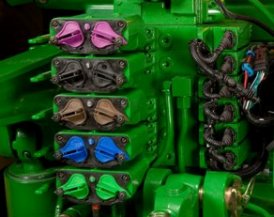 Five remote SCVs
Five remote SCVsThe field-installed electronic SCV kits are made available for tractors needing additional SCVs. These kits provide metered flow rates and timed detents with pressure and load sense compensation. The additional SCV(s) can also be integrated into the Headland Management System.
The field-installed kit includes International Organization for Standardization (ISO) lever-assisted breakaway couplers and armrest control lever.
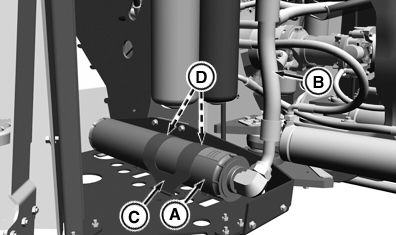
A=Hydraulic charge accumulator
B=Hydraulic hose
C=Clamp
D=Cap screws
A field installed hydraulic accumulator kit is used in applications where implements require large volumes of flowing oil for productivity. Such activities include air seeding, scraper applications or implements with multiple or large hydraulic cylinders. This attachment kit will assist the hydraulic system to maintain adequate hydraulic flow under normal operating conditions.
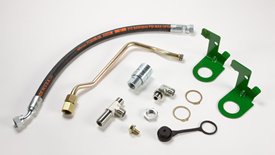 Auxiliary hitch lift assist kit
Auxiliary hitch lift assist kit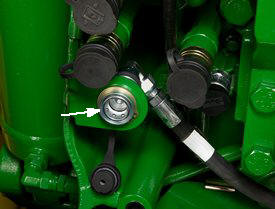 Auxiliary hitch lift assist
Auxiliary hitch lift assistLift assist wheels are often used with heavy 3-point-hitch-mounted implements. The hitch auxiliary raise kit provides hydraulic power for use with the lift assist wheels. Turning and transport are made easier using this feature.
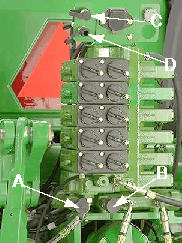 48-gpm SCV stack on a 9020 Series Tractor
48-gpm SCV stack on a 9020 Series Tractor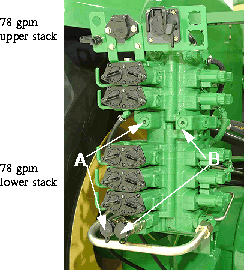 78-gpm SCV stack on a 9020 Series Tractor
78-gpm SCV stack on a 9020 Series TractorAttaching implement hydraulic hoses to locations on the tractor other than into an SCV has always been a challenge to know what kits are required for compatibility. Getting them installed in a timely manner can at times be confusing and time consuming.
To assist in making hookup to large planters, seeders, and harvesting equipment where multiple connections are required, there are now factory-installed auxiliary hydraulic couplers on wheel tractors.
For applications requiring low return oil back pressure (10 psi or less), the sump coupler kit allows oil to return directly to reservoir (differential case) from hydraulic motor, bypassing the remote coupler and SCV. When connecting motor case or seal return hose to coupler, make sure hose end and coupler are clean.
This coupler is required for correct attachment to current-production seeding products with case drain lines.
The hydraulic motor return couplers can be used as a coupler for return oil flow, from hydraulic orbital motors and other devices, to the tractor's low-pressure return port, labeled ''R'' on the tractor.
Use of this connector specifically in the return to sump port position is for hydraulic components that require a ''leak-off line'' connection to the tractor. Components and implements that require this typically are larger orbital motors that require a drain for seal protection. The connector in the sump port is not to be used to carry return flow from a function to the tractor.
Power beyond provides live hydraulic power to equipment. This kit supplies oil pressure to implements when the engine is running.
Any implement using power beyond must have a way to control oil flow. Use an independent control valve that is pressure and flow compensating (supplied separately) to control the oil flow rate from this coupler set.
The auxiliary hydraulic optional equipment includes the following:
A - Power beyond couplers
B - Hydraulic motor return couplers
C - Motor seal drain kit
D - Load sense coupler
NOTE: RE151894 and RE67182 cannot be used together.
 48-gpm SCV stack on a 9020 Series Tractor
48-gpm SCV stack on a 9020 Series Tractor 78-gpm SCV stack on a 9020 Series Tractor
78-gpm SCV stack on a 9020 Series TractorAttaching implement hydraulic hoses to locations on the tractor other than into an SCV has always been a challenge to know what kits are required for compatibility. Getting them installed in a timely manner can at times be confusing and time consuming.
To assist in making hookup to large planters, seeders, and harvesting equipment where multiple connections are required, there are now factory-installed auxiliary hydraulic couplers on wheel tractors.
For applications requiring low return oil back pressure (10 psi or less), the sump coupler kit allows oil to return directly to reservoir (differential case) from hydraulic motor, bypassing the remote coupler and SCV. When connecting motor case or seal return hose to coupler, make sure hose end and coupler are clean.
This coupler is required for correct attachment to current-production seeding products with case drain lines.
The hydraulic motor return couplers can be used as a coupler for return oil flow, from hydraulic orbital motors and other devices, to the tractor's low-pressure return port, labeled ''R'' on the tractor.
Use of this connector specifically in the return to sump port position is for hydraulic components that require a ''leak-off line'' connection to the tractor. Components and implements that require this typically are larger orbital motors that require a drain for seal protection. The connector in the sump port is not to be used to carry return flow from a function to the tractor.
Power beyond provides live hydraulic power to equipment. This kit supplies oil pressure to implements when the engine is running.
Any implement using power beyond must have a way to control oil flow. Use an independent control valve that is pressure and flow compensating (supplied separately) to control the oil flow rate from this coupler set.
The auxiliary hydraulic optional equipment includes the following:
A - Power beyond couplers
B - Hydraulic motor return couplers
C - Motor seal drain kit
D - Load sense coupler
NOTE: RE151894 and RE67182 cannot be used together.
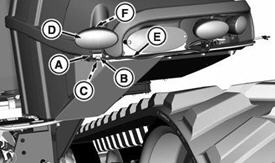
A rear fender rear facing work light is available for your tractor. The kit comes with mounting hardware and a harness which directly connects to your tractors existing harness.
This mounting location allows for illumination of your hitch and drawbar area to aid on making connections to your implement with natural lighting conditions are poor.
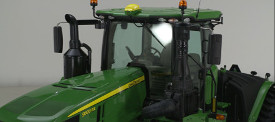
John Deere CommandView™ III cab offers several options for outside mirrors to increase rear visibility to assist in getting the view needed of variable-width implements, wagons, or carts. The wide-angle mirror options provide excellent overall rear visibility and are easily adjusted and telescope to maintain visibility for a variety of implements.
7R and 8R Series Tractor mirror options:
8RT Series Tractor mirror options:
9R and 9RX Series Tractor mirror options:
9RT Series Tractor mirror options:
Field-installed kits are also available to convert a manual mirror to an electrically adjustable mirror. See the attachment section for further information.
NOTE: Left-hand electrically telescoping mirrors are not compatible with 8RT and 9RT Tractors.
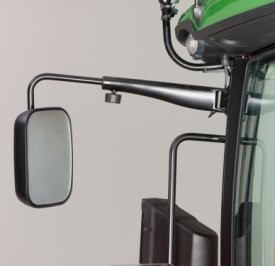 Manually adjustable, single pane mirrors
Manually adjustable, single pane mirrors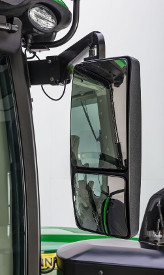 Wide-angle, heated, electrically adjustable top pane, manually telescoping mirrors
Wide-angle, heated, electrically adjustable top pane, manually telescoping mirrors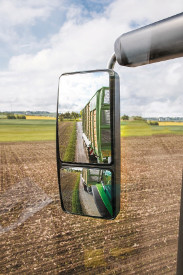 Wide-angle, heated, electrically adjustable top pane, electrically telescoping mirrors
Wide-angle, heated, electrically adjustable top pane, electrically telescoping mirrors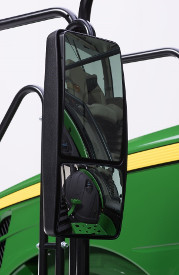 Wide-angle, heated top pane, electrically adjustable top pane, non-telescoping left-hand mirror for 8RT and 9RT Series Tractors
Wide-angle, heated top pane, electrically adjustable top pane, non-telescoping left-hand mirror for 8RT and 9RT Series Tractors
John Deere CommandView™ III cab offers several options for outside mirrors to increase rear visibility to assist in getting the view needed of variable-width implements, wagons, or carts. The wide-angle mirror options provide excellent overall rear visibility and are easily adjusted and telescope to maintain visibility for a variety of implements.
7R and 8R Series Tractor mirror options:
8RT Series Tractor mirror options:
9R and 9RX Series Tractor mirror options:
9RT Series Tractor mirror options:
Field-installed kits are also available to convert a manual mirror to an electrically adjustable mirror. See the attachment section for further information.
NOTE: Left-hand electrically telescoping mirrors are not compatible with 8RT and 9RT Tractors.
 Manually adjustable, single pane mirrors
Manually adjustable, single pane mirrors Wide-angle, heated, electrically adjustable top pane, manually telescoping mirrors
Wide-angle, heated, electrically adjustable top pane, manually telescoping mirrors Wide-angle, heated, electrically adjustable top pane, electrically telescoping mirrors
Wide-angle, heated, electrically adjustable top pane, electrically telescoping mirrors Wide-angle, heated top pane, electrically adjustable top pane, non-telescoping left-hand mirror for 8RT and 9RT Series Tractors
Wide-angle, heated top pane, electrically adjustable top pane, non-telescoping left-hand mirror for 8RT and 9RT Series Tractors
John Deere CommandView™ III cab offers several options for outside mirrors to increase rear visibility to assist in getting the view needed of variable-width implements, wagons, or carts. The wide-angle mirror options provide excellent overall rear visibility and are easily adjusted and telescope to maintain visibility for a variety of implements.
7R and 8R Series Tractor mirror options:
8RT Series Tractor mirror options:
9R and 9RX Series Tractor mirror options:
9RT Series Tractor mirror options:
Field-installed kits are also available to convert a manual mirror to an electrically adjustable mirror. See the attachment section for further information.
NOTE: Left-hand electrically telescoping mirrors are not compatible with 8RT and 9RT Tractors.
 Manually adjustable, single pane mirrors
Manually adjustable, single pane mirrors Wide-angle, heated, electrically adjustable top pane, manually telescoping mirrors
Wide-angle, heated, electrically adjustable top pane, manually telescoping mirrors Wide-angle, heated, electrically adjustable top pane, electrically telescoping mirrors
Wide-angle, heated, electrically adjustable top pane, electrically telescoping mirrors Wide-angle, heated top pane, electrically adjustable top pane, non-telescoping left-hand mirror for 8RT and 9RT Series Tractors
Wide-angle, heated top pane, electrically adjustable top pane, non-telescoping left-hand mirror for 8RT and 9RT Series TractorsMounting brackets are available to mount a standard ABC extinguisher to your tractor. The bracket mounts to the entrance platform at the top of the entrance/egress steps on 9R series tractors.
This location allows quick access to the extinguisher near the cab door, should it ever be needed.
The heavy-duty gudgeon is designed for increased loads over the standard gudgeon through larger steering pins and tapered roller bearings.
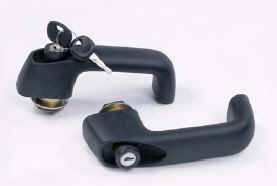 Custom key door lock kit
Custom key door lock kitField-installed kit (AL71345) allows for a door handle to be installed that has a key different from the tractor ignition key.
Cell phones, tablets, and other devices are key tools for farming today. John Deere has now made it easier than ever to incorporate these tools into the operator's station.
Stay connected with the RAM® cell phone and tablet mounts. John Deere offers a vast selection of adjustable accessory mounting solutions and media devices to fit every need and application.
 Mounting bracket with cell phone and tablet mount
Mounting bracket with cell phone and tablet mount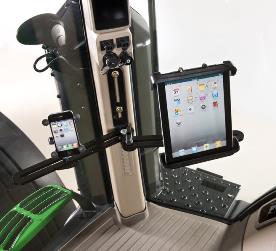 Mounting bracket with cell phone and tablet mount
Mounting bracket with cell phone and tablet mountRAM is a trademark of National Products Inc.
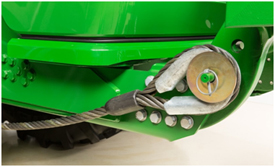 Tow cable front hook
Tow cable front hook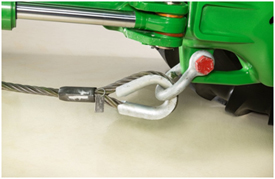 Rear tow cable connection point
Rear tow cable connection pointThe front tow cable is recommended for pulling all 9 Family Tractors in time of needed assistance. Tow cables are available as a factory-installed option on all ag tractors and are base equipment on all Scraper Special Tractors. The tow cable attaches to the area in front of the drawbar and is also available as a field-installed option.
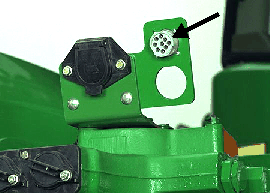 9-pin electrical connector
9-pin electrical connectorThe 9-pin electrical connector is required to allow TouchSet depth control to be used with implements with this feature. The harness provides a position input to the tractor selective control valve unit enabling the TouchSet system.
This feature allows the operator to adjust height and depth of remote lift cylinders by using the TouchSet controls in the cab.
Cell phones, tablets, and other devices are key tools for farming today. John Deere has now made it easier than ever to incorporate these tools into the operator's station.
Stay connected with the RAM® cell phone and tablet mounts. John Deere offers a vast selection of adjustable accessory mounting solutions and media devices to fit every need and application.
 Mounting bracket with cell phone and tablet mount
Mounting bracket with cell phone and tablet mount Mounting bracket with cell phone and tablet mount
Mounting bracket with cell phone and tablet mountRAM is a trademark of National Products Inc.
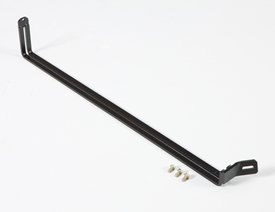 Accessories mounting bracket
Accessories mounting bracket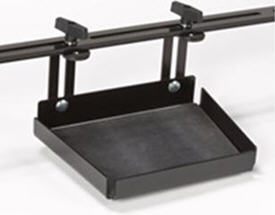 Tray kit
Tray kitThe accessories bracket is available for mounting monitors, phones, radios, and other accessories in one convenient location.
The bracket connects in the existing holes inside the cab.
This kit provides antenna mount, radio mounting plate, and wiring for a business band radio.
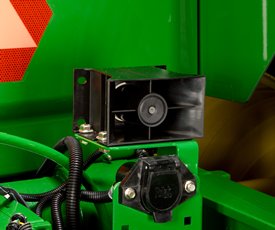 Backup alarm on a 9R Series Tractor
Backup alarm on a 9R Series Tractor
To better accommodate governmental or commercial sales, a back-up alarm is available as a factory- or field-installed attachment on select models. An alarm sounds whenever the transmission is placed in reverse. The alarm provides a high level of warning that the tractor is changing direction.
A backup alarm is base equipment on 9R and 9RT Scraper Special Series Tractors.
Cell phones, tablets, and other devices are key tools for farming today. John Deere has now made it easier than ever to incorporate these tools into the operator's station.
Stay connected with the RAM® cell phone and tablet mounts. John Deere offers a vast selection of adjustable accessory mounting solutions and media devices to fit every need and application.
 Mounting bracket with cell phone and tablet mount
Mounting bracket with cell phone and tablet mount Mounting bracket with cell phone and tablet mount
Mounting bracket with cell phone and tablet mountRAM is a trademark of National Products Inc.
The floor insulation kit can reduce cab heat generated by transmission and hydraulic oil temperatures below the cab floor. It can reduce the overall cab temperature, as it works as a thermal barrier. The product comes in a large sheet, which is easily cut to fit the contours of the cab floor.
The kit is large enough to fit the floor pan design of 6 through 9 Series Tractor cabs.
A favorite worldwide, the RAM self-leveling cup holder is now available as a kit - designed specifically for Deere equipment. It is easily installed to keep your favorite beverage upright even in the roughest terrain. The perfect accessory for any cab that has 10-mm mounting bosses.
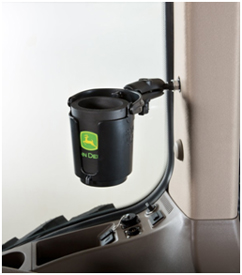 Self-leveling cup holder John Deere branded beverage insulator included
Self-leveling cup holder John Deere branded beverage insulator included
The new cup holder features a unique self-leveling design. This pivoting design allows easy adjustment for the holder while offsetting motion of the vehicle when moving.
Features and applications:
The producer can utilize various integrated technologies during sprayer operation and the following attachments allow them to properly fit, display, and charge these accessories:
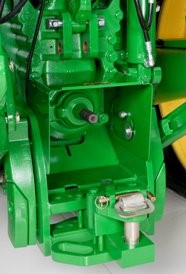 PTO and shield
PTO and shieldFully independent 1000-rpm PTO is available as a factory- or field-installed option.
The 9R Series Tractor utilizes an EH PTO-engagement switch to activate the optional 1000-rpm PTO.
This kit replaces the rear upholstery behind the operator seat with an additional panel containing a grille screen and base speaker. It allows the tractor to reproduce a deeper range of base tones with seamless installation. The clean look and powerful sound adds a level of comfort and enjoyment for long days in the cab.
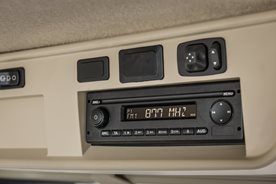 Radio
RadioJohn Deere radio packages provide powerful performance with standard four-speaker systems. The standard radio package features easy-to-use operator controls located on the CommandCenter™ display and at the radio faceplate. AM/FM and weatherband tuner allows operators to stay tuned to their favorite radio stations and keep current with ever-changing weather patterns. An auxiliary input for connecting an external media source is conveniently located on the right-side console.
The premium radio package adds to these great features with Bluetooth® to connect with compatible media devices and a USB input for connecting external media sources. A subwoofer is also available in this package to increase the operator experience within the cab.
Both radio packages help create a comfortable operator environment for long hours in the cab.
*XM Satellite functionality for premium radio needs to be upgraded by purchasing the XM antenna, XM receiver, brackets, and wiring harnesses via a kit from your local John Deere dealer.
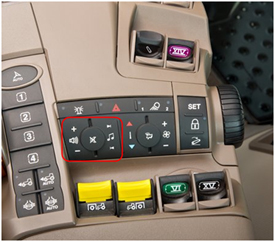 Radio controls
Radio controlsBosch is a trademark of Robert Bosch GmBH. Bluetooth is a trademark of Bluetooth SIG Incorporated. XM is a trademark of XM Satellite Radio Incorporated. Delco is a trademark of General Motors LLC.
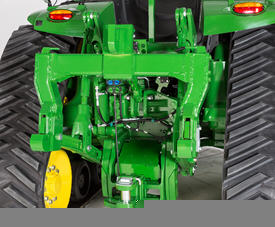 Quik-Coupler
Quik-CouplerHitch/coupler allows for quick, no-hassle hookups to many popular integral implements.
Features include:
 Quik-Coupler
Quik-CouplerHitch/coupler allows for quick, no-hassle hookups to many popular integral implements.
Features include:
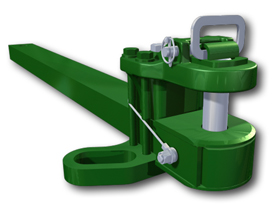 Conversion kit
Conversion kitAn option for a factory-equipped Category 5 drawbar with a Category 4 conversion kit included is available on 9420RX and 9470RX Tractors for producers who have Category 4 implements that cannot be converted to Category 5.
A Category 5 to Category 4 drawbar conversion kit is also available as an attachment kit.
NOTE: The preferred method when operating high-horsepower tractors is to convert implements to Category 5.
For additional implement information, please reference the planting and seeding or the tillage information.
 3-point hitch
3-point hitchA 3-point hitch with Quik-Coupler is available as a factory- or field-installed option.
Electronic draft-sensing relays load information to the electrohydraulic hitch control module for fast, smooth, accurate hitch corrections.
Tractors used in deep-ripping applications with hitch-mounted implements and all other applications with high vertical loads on the rear of the tractor are recommended to be equipped with a cast-tapered roller-bearing gudgeon. Tractors equipped with dozer blades for silage packing operations are also recommended to be equipped with this option.
If ordering a 3-point hitch with standard flow hydraulics, four, five, or six selective control valves (SCVs) are available.
If ordering a 3-point hitch with high-flow hydraulics, five or six SCVs are available.
Model | 9370R | 9420R | 9470R | 9520R | 9570R | 9620R | |
Code: | Category 4N/3 | x | x | x | |||
Code: | Category 4/4N | x | x | x | x | x | x |
Code: | Category 4N/3 | x | x | x | |||
Code: | Category 4/4N | x | x | x | x | x | x |
*Factory observed*
An ergonomically-designed hitch command control console makes it easy to operate the hitch. See the hitch controls section for more information.
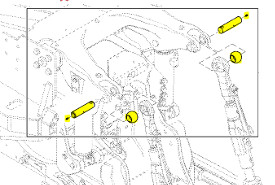 Greaseable pin kit
Greaseable pin kitThe rear hitch has pin joints located in the top lift carrier that uses pins (R304684) which can wear and require replacing to restore smooth operation over time.
The heavy-duty greasable pin kit provides a greasing zerk fitting on each pin for a grease shot to be included as part of the tractor’s grease maintenance.
This kit allows for the pin replacement to last far longer than the standard installed pin so long as it is regularly greased. This update will reduce or eliminate the need for future pin replacement in this joint.
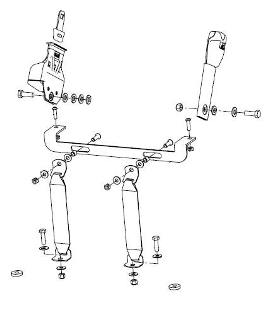 Seat belt for 8R Series Tractors
Seat belt for 8R Series TractorsThe 3-in. field-installed seat belt kit is designed for use with the 8R and 8RT Series Tractor operator seats. The seat belt kit is offered to meet regulations that require a seat belt anchorage force similar to the SAE J386 (including previous versions up to 22.2 kN anchorage strength), IOS 6683, and OSHA requirements (29CFR1926.602) for earthmoving operations and non-agricultural tractor operations.
NOTE: John Deere recommends reviewing the seat belt kit performance capabilities to ensure compliance with local, state, regional, and national requirements.
 9RX with 91.4-cm (36-in.) tracks and 304.8-cm (120-in.) track spacing
9RX with 91.4-cm (36-in.) tracks and 304.8-cm (120-in.) track spacing9RX Series Tractors equipped with 304.8-cm (120-in.) track spacing provide increased stability and allow producers to operate on 304.8-cm (120-in.) centers for controlled traffic farming. They also provide improved track-to-frame clearance for better access to the undercarriage for serviceability and material cleanout. John Deere is the first and only tractor manufacturer to offer a 304.8-cm (120-in.) track spacing option on four-track tractors with 76.2-cm (30-in.) and 91.4-cm (36-in.) tracks up to 462.3 kW (620 hp).
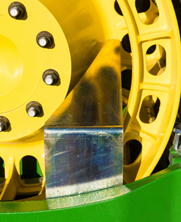 Inner drive sprocket mud scraper (wide track shown)
Inner drive sprocket mud scraper (wide track shown)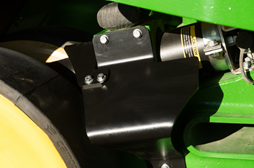 Idler debris shield (wide track shown)
Idler debris shield (wide track shown)
The 9RX Series undercarriage includes mud scrapers on the outer circumference of the drive sprocket as standard equipment.
There are two additional self-cleaning kits available as an attachment.
The inner drive-sprocket mud scraper continuously removes bulk debris from the sprocket hub and discards it to the outside of the track assembly while the tractor is in forward motion.
The idler debris shield is attached to the rearward idler and continuously removes bulk debris from the idler as well as protects the track-tensioning cylinders from light impact and debris buildup while the tractor is in forward motion.
Both kits are designed to significantly reduce mud, sand, rocks, and other potential buildup in the track assembly, while also increasing track belt life by discarding debris directly to the ground rather than on the track surface. Kits are available in two sizes depending on wide- or narrow-track undercarriage.
 Inner drive sprocket mud scraper (wide track shown)
Inner drive sprocket mud scraper (wide track shown) Idler debris shield (wide track shown)
Idler debris shield (wide track shown)
The 9RX Series undercarriage includes mud scrapers on the outer circumference of the drive sprocket as standard equipment.
There are two additional self-cleaning kits available as an attachment.
The inner drive-sprocket mud scraper continuously removes bulk debris from the sprocket hub and discards it to the outside of the track assembly while the tractor is in forward motion.
The idler debris shield is attached to the rearward idler and continuously removes bulk debris from the idler as well as protects the track-tensioning cylinders from light impact and debris buildup while the tractor is in forward motion.
Both kits are designed to significantly reduce mud, sand, rocks, and other potential buildup in the track assembly, while also increasing track belt life by discarding debris directly to the ground rather than on the track surface. Kits are available in two sizes depending on wide- or narrow-track undercarriage.
 Inner drive sprocket mud scraper (wide track shown)
Inner drive sprocket mud scraper (wide track shown) Idler debris shield (wide track shown)
Idler debris shield (wide track shown)
The 9RX Series undercarriage includes mud scrapers on the outer circumference of the drive sprocket as standard equipment.
There are two additional self-cleaning kits available as an attachment.
The inner drive-sprocket mud scraper continuously removes bulk debris from the sprocket hub and discards it to the outside of the track assembly while the tractor is in forward motion.
The idler debris shield is attached to the rearward idler and continuously removes bulk debris from the idler as well as protects the track-tensioning cylinders from light impact and debris buildup while the tractor is in forward motion.
Both kits are designed to significantly reduce mud, sand, rocks, and other potential buildup in the track assembly, while also increasing track belt life by discarding debris directly to the ground rather than on the track surface. Kits are available in two sizes depending on wide- or narrow-track undercarriage.
 Inner drive sprocket mud scraper (wide track shown)
Inner drive sprocket mud scraper (wide track shown) Idler debris shield (wide track shown)
Idler debris shield (wide track shown)
The 9RX Series undercarriage includes mud scrapers on the outer circumference of the drive sprocket as standard equipment.
There are two additional self-cleaning kits available as an attachment.
The inner drive-sprocket mud scraper continuously removes bulk debris from the sprocket hub and discards it to the outside of the track assembly while the tractor is in forward motion.
The idler debris shield is attached to the rearward idler and continuously removes bulk debris from the idler as well as protects the track-tensioning cylinders from light impact and debris buildup while the tractor is in forward motion.
Both kits are designed to significantly reduce mud, sand, rocks, and other potential buildup in the track assembly, while also increasing track belt life by discarding debris directly to the ground rather than on the track surface. Kits are available in two sizes depending on wide- or narrow-track undercarriage.
9RX Series Tractors equipped with 18-in. and 24-in. tracks operating on sidehill or slopes of 14 degrees or 25 percent for long periods of time should install a sidehill idler spacer kit.
This kit includes shims and mounting hardware that will increase the space between the rear idlers and track guide lugs. This kit will help extend guide lug life when working on sidehills by increasing clearance between rear idlers and guide lugs and decreasing heat buildup in the guide lugs.
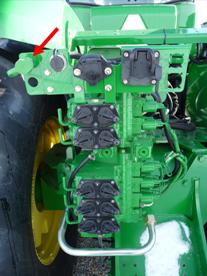 Brake coupler on a 9030 Series Tractor
Brake coupler on a 9030 Series Tractor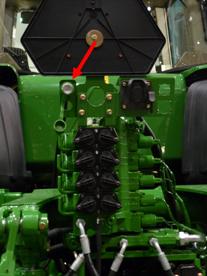 Brake coupler on a 9030T Series Tractor
Brake coupler on a 9030T Series Tractor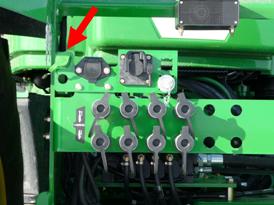 Brake coupler on a 9030 Series Scraper Tractor
Brake coupler on a 9030 Series Scraper TractorThe hydraulic trailer brake kit, available as factory- or field-installed on the 9030 Series Tractors (field-installed available on 9020 Series), will assist in the braking of John Deere tractors and large heavy implements.
This hydraulic brake kit provides single line connection to hydraulic braking systems. The kit contains the necessary components along with the tractor's hydraulics to operate implements equipped with proper hydraulic brake components.
NOTE: Trailer brakes are not compatible on 9120, 9220, and 9230 models.
 Brake coupler on a 9030 Series Tractor
Brake coupler on a 9030 Series Tractor Brake coupler on a 9030T Series Tractor
Brake coupler on a 9030T Series Tractor Brake coupler on a 9030 Series Scraper Tractor
Brake coupler on a 9030 Series Scraper TractorThe hydraulic trailer brake kit, available as factory- or field-installed on the 9030 Series Tractors (field-installed available on 9020 Series), will assist in the braking of John Deere tractors and large heavy implements.
This hydraulic brake kit provides single line connection to hydraulic braking systems. The kit contains the necessary components along with the tractor's hydraulics to operate implements equipped with proper hydraulic brake components.
NOTE: Trailer brakes are not compatible on 9120, 9220, and 9230 models.
© COPYRIGHT 2025 LEGACY EQUIPMENT - ALL RIGHTS RESERVED| Privacy Policy | Powered By